Management Accounting and Techniques for Financial Reporting
VerifiedAdded on 2023/01/17
|18
|4778
|37
AI Summary
This document provides an overview of management accounting and its essential requirements. It discusses the different methods used for management accounting report, including cost accounting techniques to prepare an income statement. It also explores the use of management accounting techniques for financial reporting. The document is relevant for students studying management accounting or anyone interested in understanding the role of management accounting in financial reporting.
Contribute Materials
Your contribution can guide someone’s learning journey. Share your
documents today.
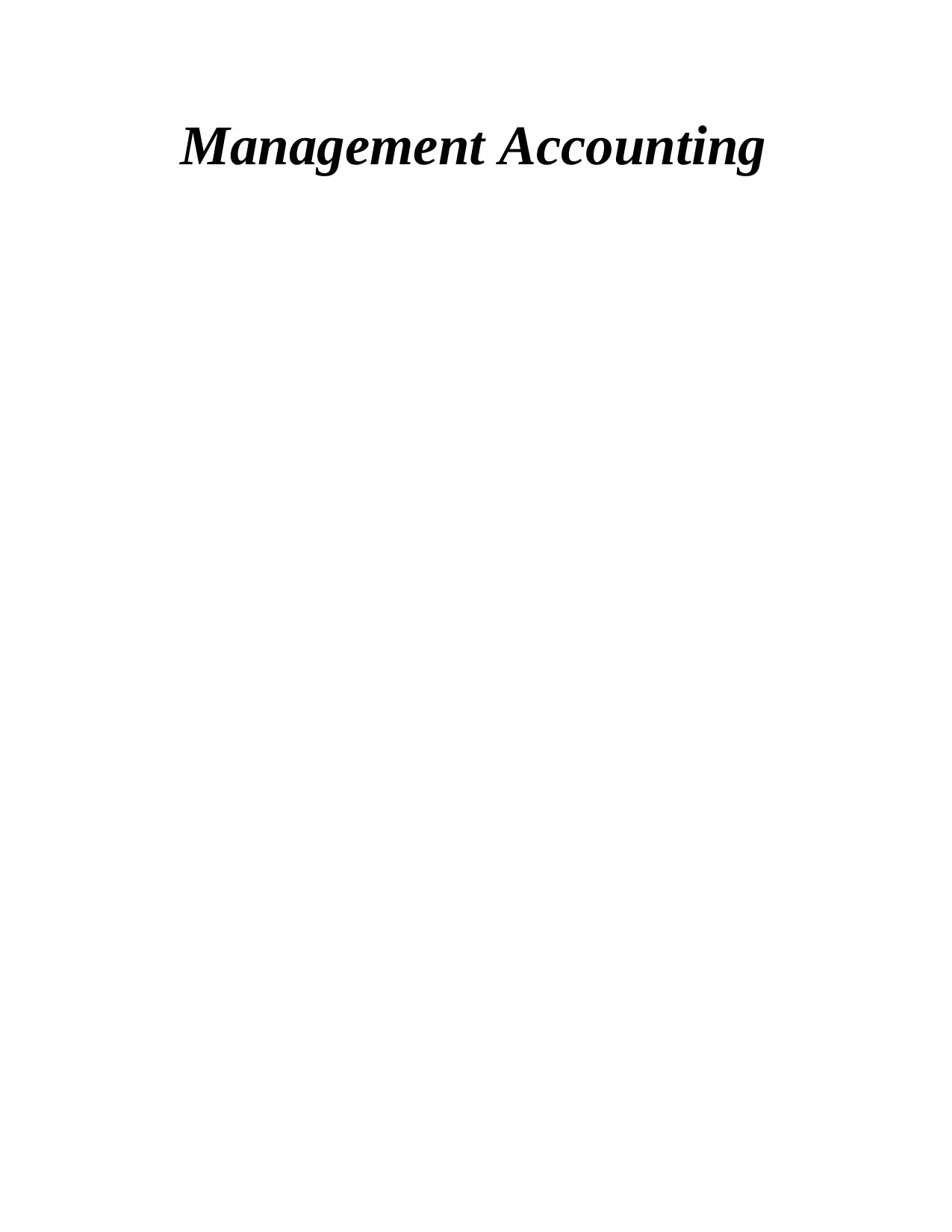
Management Accounting
Secure Best Marks with AI Grader
Need help grading? Try our AI Grader for instant feedback on your assignments.
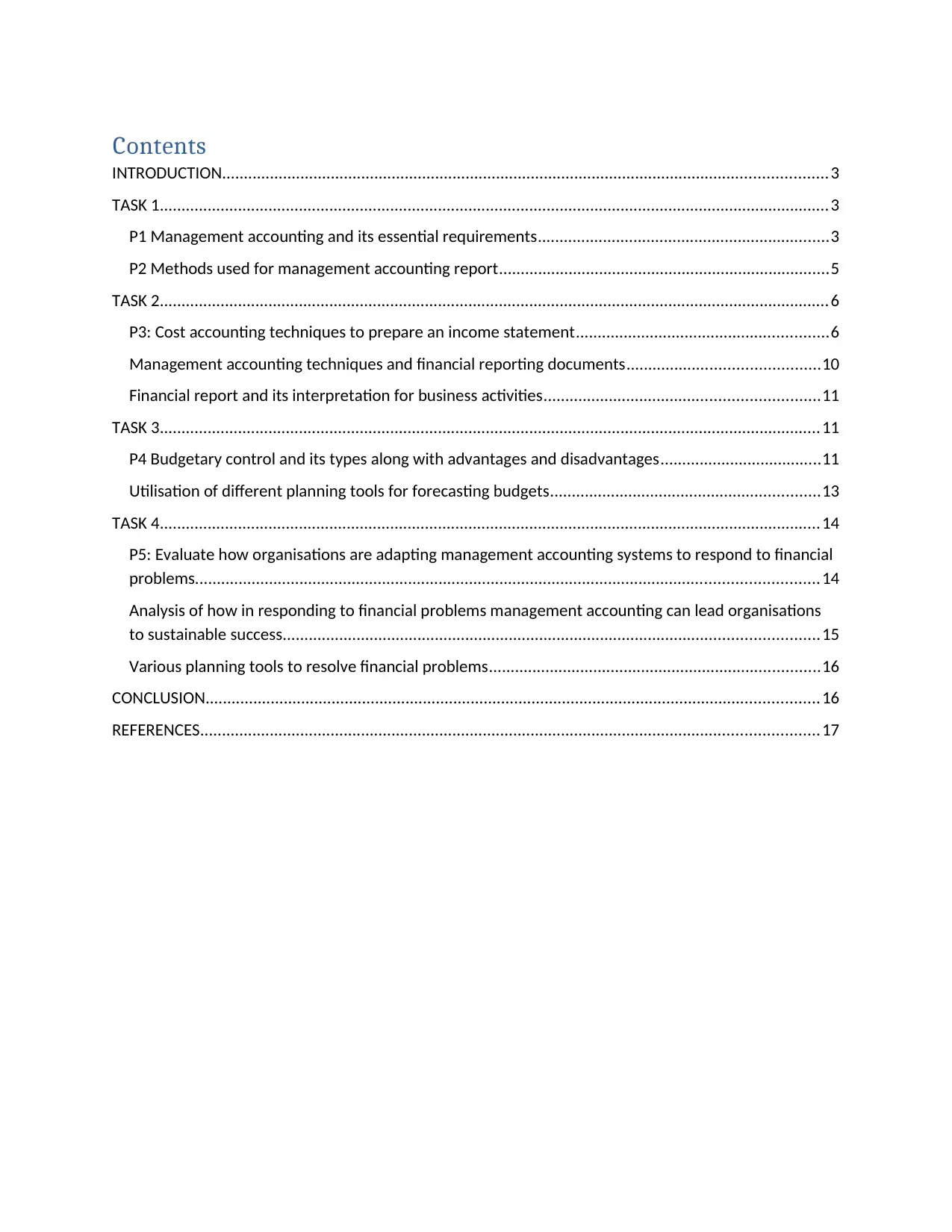
Contents
INTRODUCTION...........................................................................................................................................3
TASK 1..........................................................................................................................................................3
P1 Management accounting and its essential requirements...................................................................3
P2 Methods used for management accounting report............................................................................5
TASK 2..........................................................................................................................................................6
P3: Cost accounting techniques to prepare an income statement..........................................................6
Management accounting techniques and financial reporting documents............................................10
Financial report and its interpretation for business activities...............................................................11
TASK 3........................................................................................................................................................11
P4 Budgetary control and its types along with advantages and disadvantages.....................................11
Utilisation of different planning tools for forecasting budgets..............................................................13
TASK 4........................................................................................................................................................14
P5: Evaluate how organisations are adapting management accounting systems to respond to financial
problems...............................................................................................................................................14
Analysis of how in responding to financial problems management accounting can lead organisations
to sustainable success...........................................................................................................................15
Various planning tools to resolve financial problems............................................................................16
CONCLUSION.............................................................................................................................................16
REFERENCES..............................................................................................................................................17
INTRODUCTION...........................................................................................................................................3
TASK 1..........................................................................................................................................................3
P1 Management accounting and its essential requirements...................................................................3
P2 Methods used for management accounting report............................................................................5
TASK 2..........................................................................................................................................................6
P3: Cost accounting techniques to prepare an income statement..........................................................6
Management accounting techniques and financial reporting documents............................................10
Financial report and its interpretation for business activities...............................................................11
TASK 3........................................................................................................................................................11
P4 Budgetary control and its types along with advantages and disadvantages.....................................11
Utilisation of different planning tools for forecasting budgets..............................................................13
TASK 4........................................................................................................................................................14
P5: Evaluate how organisations are adapting management accounting systems to respond to financial
problems...............................................................................................................................................14
Analysis of how in responding to financial problems management accounting can lead organisations
to sustainable success...........................................................................................................................15
Various planning tools to resolve financial problems............................................................................16
CONCLUSION.............................................................................................................................................16
REFERENCES..............................................................................................................................................17
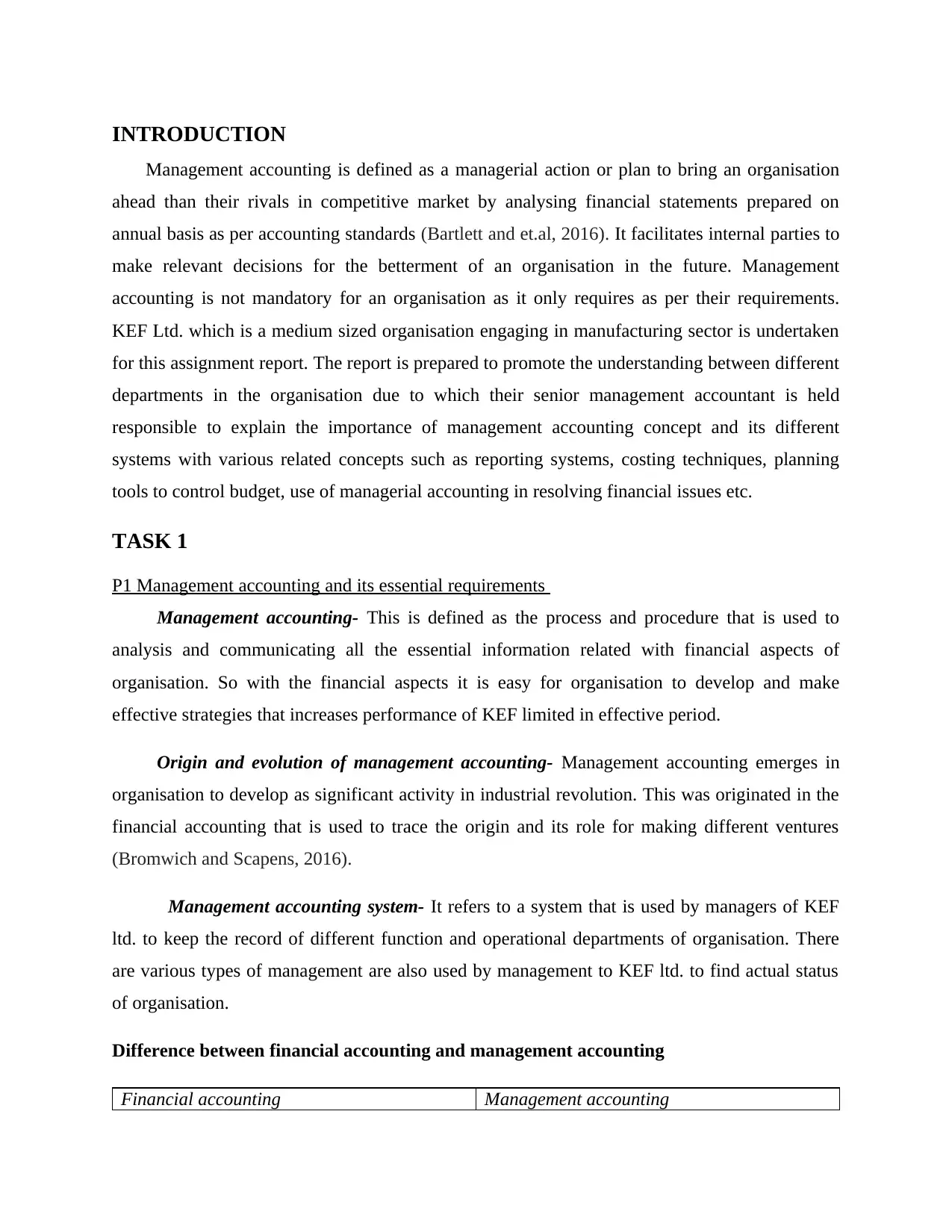
INTRODUCTION
Management accounting is defined as a managerial action or plan to bring an organisation
ahead than their rivals in competitive market by analysing financial statements prepared on
annual basis as per accounting standards (Bartlett and et.al, 2016). It facilitates internal parties to
make relevant decisions for the betterment of an organisation in the future. Management
accounting is not mandatory for an organisation as it only requires as per their requirements.
KEF Ltd. which is a medium sized organisation engaging in manufacturing sector is undertaken
for this assignment report. The report is prepared to promote the understanding between different
departments in the organisation due to which their senior management accountant is held
responsible to explain the importance of management accounting concept and its different
systems with various related concepts such as reporting systems, costing techniques, planning
tools to control budget, use of managerial accounting in resolving financial issues etc.
TASK 1
P1 Management accounting and its essential requirements
Management accounting- This is defined as the process and procedure that is used to
analysis and communicating all the essential information related with financial aspects of
organisation. So with the financial aspects it is easy for organisation to develop and make
effective strategies that increases performance of KEF limited in effective period.
Origin and evolution of management accounting- Management accounting emerges in
organisation to develop as significant activity in industrial revolution. This was originated in the
financial accounting that is used to trace the origin and its role for making different ventures
(Bromwich and Scapens, 2016).
Management accounting system- It refers to a system that is used by managers of KEF
ltd. to keep the record of different function and operational departments of organisation. There
are various types of management are also used by management to KEF ltd. to find actual status
of organisation.
Difference between financial accounting and management accounting
Financial accounting Management accounting
Management accounting is defined as a managerial action or plan to bring an organisation
ahead than their rivals in competitive market by analysing financial statements prepared on
annual basis as per accounting standards (Bartlett and et.al, 2016). It facilitates internal parties to
make relevant decisions for the betterment of an organisation in the future. Management
accounting is not mandatory for an organisation as it only requires as per their requirements.
KEF Ltd. which is a medium sized organisation engaging in manufacturing sector is undertaken
for this assignment report. The report is prepared to promote the understanding between different
departments in the organisation due to which their senior management accountant is held
responsible to explain the importance of management accounting concept and its different
systems with various related concepts such as reporting systems, costing techniques, planning
tools to control budget, use of managerial accounting in resolving financial issues etc.
TASK 1
P1 Management accounting and its essential requirements
Management accounting- This is defined as the process and procedure that is used to
analysis and communicating all the essential information related with financial aspects of
organisation. So with the financial aspects it is easy for organisation to develop and make
effective strategies that increases performance of KEF limited in effective period.
Origin and evolution of management accounting- Management accounting emerges in
organisation to develop as significant activity in industrial revolution. This was originated in the
financial accounting that is used to trace the origin and its role for making different ventures
(Bromwich and Scapens, 2016).
Management accounting system- It refers to a system that is used by managers of KEF
ltd. to keep the record of different function and operational departments of organisation. There
are various types of management are also used by management to KEF ltd. to find actual status
of organisation.
Difference between financial accounting and management accounting
Financial accounting Management accounting
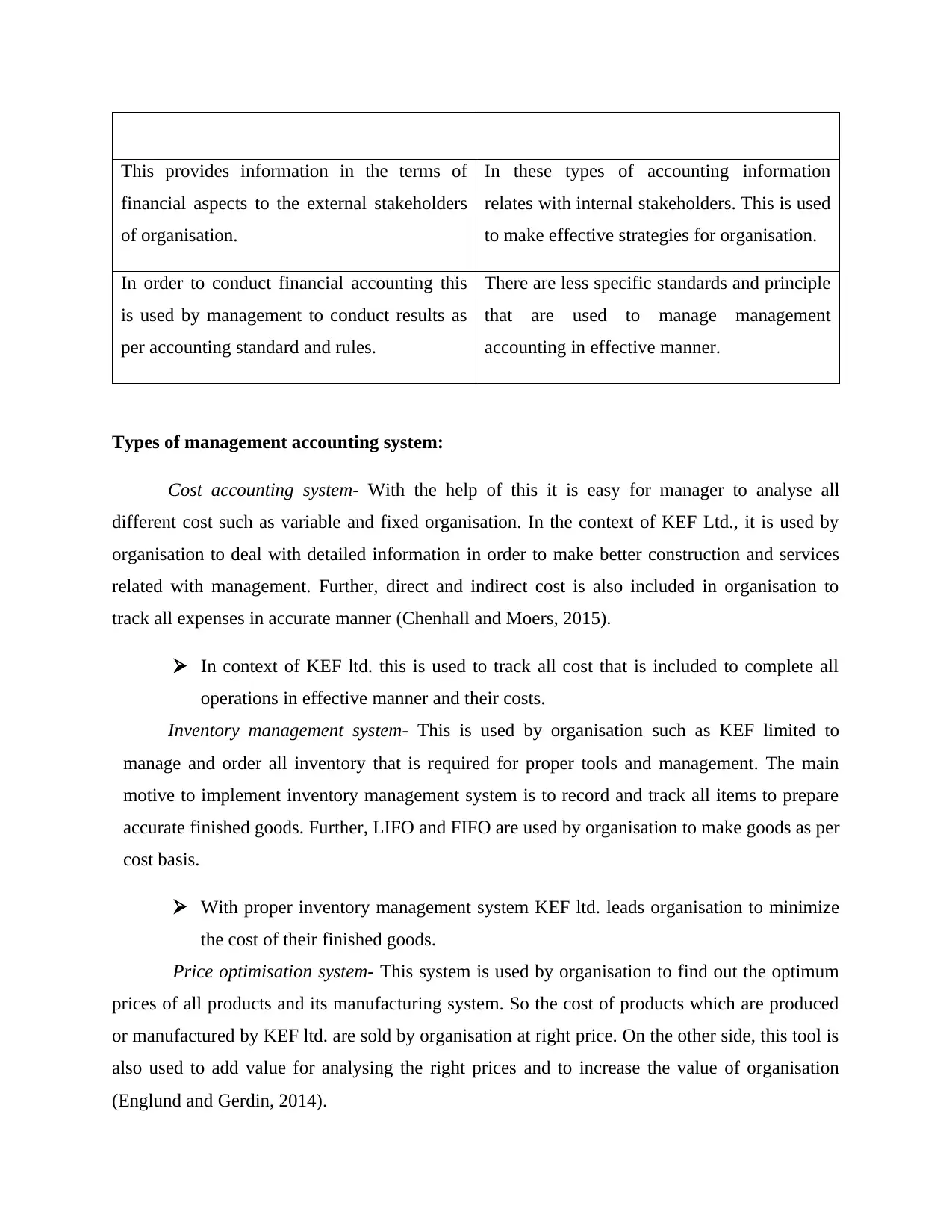
This provides information in the terms of
financial aspects to the external stakeholders
of organisation.
In these types of accounting information
relates with internal stakeholders. This is used
to make effective strategies for organisation.
In order to conduct financial accounting this
is used by management to conduct results as
per accounting standard and rules.
There are less specific standards and principle
that are used to manage management
accounting in effective manner.
Types of management accounting system:
Cost accounting system- With the help of this it is easy for manager to analyse all
different cost such as variable and fixed organisation. In the context of KEF Ltd., it is used by
organisation to deal with detailed information in order to make better construction and services
related with management. Further, direct and indirect cost is also included in organisation to
track all expenses in accurate manner (Chenhall and Moers, 2015).
In context of KEF ltd. this is used to track all cost that is included to complete all
operations in effective manner and their costs.
Inventory management system- This is used by organisation such as KEF limited to
manage and order all inventory that is required for proper tools and management. The main
motive to implement inventory management system is to record and track all items to prepare
accurate finished goods. Further, LIFO and FIFO are used by organisation to make goods as per
cost basis.
With proper inventory management system KEF ltd. leads organisation to minimize
the cost of their finished goods.
Price optimisation system- This system is used by organisation to find out the optimum
prices of all products and its manufacturing system. So the cost of products which are produced
or manufactured by KEF ltd. are sold by organisation at right price. On the other side, this tool is
also used to add value for analysing the right prices and to increase the value of organisation
(Englund and Gerdin, 2014).
financial aspects to the external stakeholders
of organisation.
In these types of accounting information
relates with internal stakeholders. This is used
to make effective strategies for organisation.
In order to conduct financial accounting this
is used by management to conduct results as
per accounting standard and rules.
There are less specific standards and principle
that are used to manage management
accounting in effective manner.
Types of management accounting system:
Cost accounting system- With the help of this it is easy for manager to analyse all
different cost such as variable and fixed organisation. In the context of KEF Ltd., it is used by
organisation to deal with detailed information in order to make better construction and services
related with management. Further, direct and indirect cost is also included in organisation to
track all expenses in accurate manner (Chenhall and Moers, 2015).
In context of KEF ltd. this is used to track all cost that is included to complete all
operations in effective manner and their costs.
Inventory management system- This is used by organisation such as KEF limited to
manage and order all inventory that is required for proper tools and management. The main
motive to implement inventory management system is to record and track all items to prepare
accurate finished goods. Further, LIFO and FIFO are used by organisation to make goods as per
cost basis.
With proper inventory management system KEF ltd. leads organisation to minimize
the cost of their finished goods.
Price optimisation system- This system is used by organisation to find out the optimum
prices of all products and its manufacturing system. So the cost of products which are produced
or manufactured by KEF ltd. are sold by organisation at right price. On the other side, this tool is
also used to add value for analysing the right prices and to increase the value of organisation
(Englund and Gerdin, 2014).
Secure Best Marks with AI Grader
Need help grading? Try our AI Grader for instant feedback on your assignments.
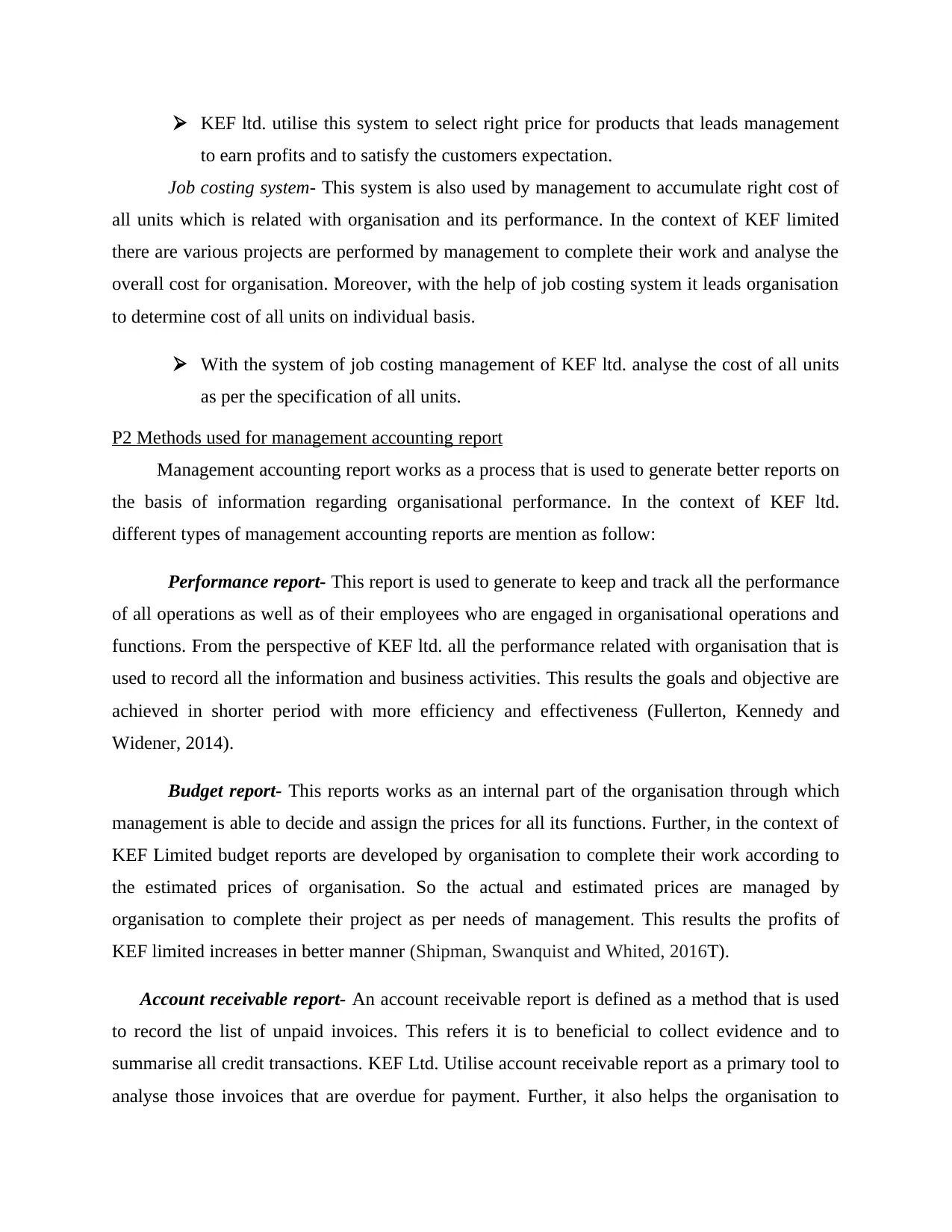
KEF ltd. utilise this system to select right price for products that leads management
to earn profits and to satisfy the customers expectation.
Job costing system- This system is also used by management to accumulate right cost of
all units which is related with organisation and its performance. In the context of KEF limited
there are various projects are performed by management to complete their work and analyse the
overall cost for organisation. Moreover, with the help of job costing system it leads organisation
to determine cost of all units on individual basis.
With the system of job costing management of KEF ltd. analyse the cost of all units
as per the specification of all units.
P2 Methods used for management accounting report
Management accounting report works as a process that is used to generate better reports on
the basis of information regarding organisational performance. In the context of KEF ltd.
different types of management accounting reports are mention as follow:
Performance report- This report is used to generate to keep and track all the performance
of all operations as well as of their employees who are engaged in organisational operations and
functions. From the perspective of KEF ltd. all the performance related with organisation that is
used to record all the information and business activities. This results the goals and objective are
achieved in shorter period with more efficiency and effectiveness (Fullerton, Kennedy and
Widener, 2014).
Budget report- This reports works as an internal part of the organisation through which
management is able to decide and assign the prices for all its functions. Further, in the context of
KEF Limited budget reports are developed by organisation to complete their work according to
the estimated prices of organisation. So the actual and estimated prices are managed by
organisation to complete their project as per needs of management. This results the profits of
KEF limited increases in better manner (Shipman, Swanquist and Whited, 2016T).
Account receivable report- An account receivable report is defined as a method that is used
to record the list of unpaid invoices. This refers it is to beneficial to collect evidence and to
summarise all credit transactions. KEF Ltd. Utilise account receivable report as a primary tool to
analyse those invoices that are overdue for payment. Further, it also helps the organisation to
to earn profits and to satisfy the customers expectation.
Job costing system- This system is also used by management to accumulate right cost of
all units which is related with organisation and its performance. In the context of KEF limited
there are various projects are performed by management to complete their work and analyse the
overall cost for organisation. Moreover, with the help of job costing system it leads organisation
to determine cost of all units on individual basis.
With the system of job costing management of KEF ltd. analyse the cost of all units
as per the specification of all units.
P2 Methods used for management accounting report
Management accounting report works as a process that is used to generate better reports on
the basis of information regarding organisational performance. In the context of KEF ltd.
different types of management accounting reports are mention as follow:
Performance report- This report is used to generate to keep and track all the performance
of all operations as well as of their employees who are engaged in organisational operations and
functions. From the perspective of KEF ltd. all the performance related with organisation that is
used to record all the information and business activities. This results the goals and objective are
achieved in shorter period with more efficiency and effectiveness (Fullerton, Kennedy and
Widener, 2014).
Budget report- This reports works as an internal part of the organisation through which
management is able to decide and assign the prices for all its functions. Further, in the context of
KEF Limited budget reports are developed by organisation to complete their work according to
the estimated prices of organisation. So the actual and estimated prices are managed by
organisation to complete their project as per needs of management. This results the profits of
KEF limited increases in better manner (Shipman, Swanquist and Whited, 2016T).
Account receivable report- An account receivable report is defined as a method that is used
to record the list of unpaid invoices. This refers it is to beneficial to collect evidence and to
summarise all credit transactions. KEF Ltd. Utilise account receivable report as a primary tool to
analyse those invoices that are overdue for payment. Further, it also helps the organisation to
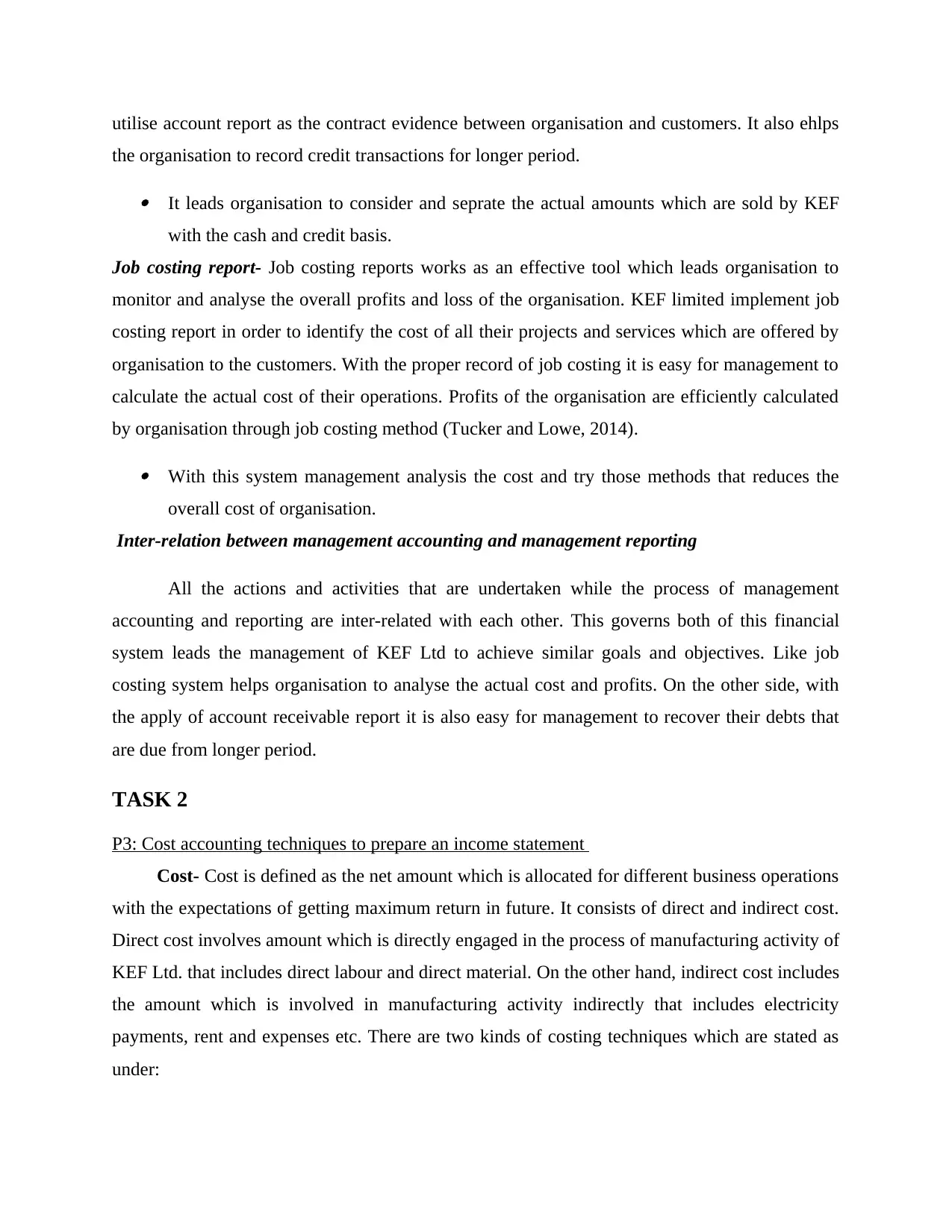
utilise account report as the contract evidence between organisation and customers. It also ehlps
the organisation to record credit transactions for longer period.
It leads organisation to consider and seprate the actual amounts which are sold by KEF
with the cash and credit basis.
Job costing report- Job costing reports works as an effective tool which leads organisation to
monitor and analyse the overall profits and loss of the organisation. KEF limited implement job
costing report in order to identify the cost of all their projects and services which are offered by
organisation to the customers. With the proper record of job costing it is easy for management to
calculate the actual cost of their operations. Profits of the organisation are efficiently calculated
by organisation through job costing method (Tucker and Lowe, 2014).
With this system management analysis the cost and try those methods that reduces the
overall cost of organisation.
Inter-relation between management accounting and management reporting
All the actions and activities that are undertaken while the process of management
accounting and reporting are inter-related with each other. This governs both of this financial
system leads the management of KEF Ltd to achieve similar goals and objectives. Like job
costing system helps organisation to analyse the actual cost and profits. On the other side, with
the apply of account receivable report it is also easy for management to recover their debts that
are due from longer period.
TASK 2
P3: Cost accounting techniques to prepare an income statement
Cost- Cost is defined as the net amount which is allocated for different business operations
with the expectations of getting maximum return in future. It consists of direct and indirect cost.
Direct cost involves amount which is directly engaged in the process of manufacturing activity of
KEF Ltd. that includes direct labour and direct material. On the other hand, indirect cost includes
the amount which is involved in manufacturing activity indirectly that includes electricity
payments, rent and expenses etc. There are two kinds of costing techniques which are stated as
under:
the organisation to record credit transactions for longer period.
It leads organisation to consider and seprate the actual amounts which are sold by KEF
with the cash and credit basis.
Job costing report- Job costing reports works as an effective tool which leads organisation to
monitor and analyse the overall profits and loss of the organisation. KEF limited implement job
costing report in order to identify the cost of all their projects and services which are offered by
organisation to the customers. With the proper record of job costing it is easy for management to
calculate the actual cost of their operations. Profits of the organisation are efficiently calculated
by organisation through job costing method (Tucker and Lowe, 2014).
With this system management analysis the cost and try those methods that reduces the
overall cost of organisation.
Inter-relation between management accounting and management reporting
All the actions and activities that are undertaken while the process of management
accounting and reporting are inter-related with each other. This governs both of this financial
system leads the management of KEF Ltd to achieve similar goals and objectives. Like job
costing system helps organisation to analyse the actual cost and profits. On the other side, with
the apply of account receivable report it is also easy for management to recover their debts that
are due from longer period.
TASK 2
P3: Cost accounting techniques to prepare an income statement
Cost- Cost is defined as the net amount which is allocated for different business operations
with the expectations of getting maximum return in future. It consists of direct and indirect cost.
Direct cost involves amount which is directly engaged in the process of manufacturing activity of
KEF Ltd. that includes direct labour and direct material. On the other hand, indirect cost includes
the amount which is involved in manufacturing activity indirectly that includes electricity
payments, rent and expenses etc. There are two kinds of costing techniques which are stated as
under:
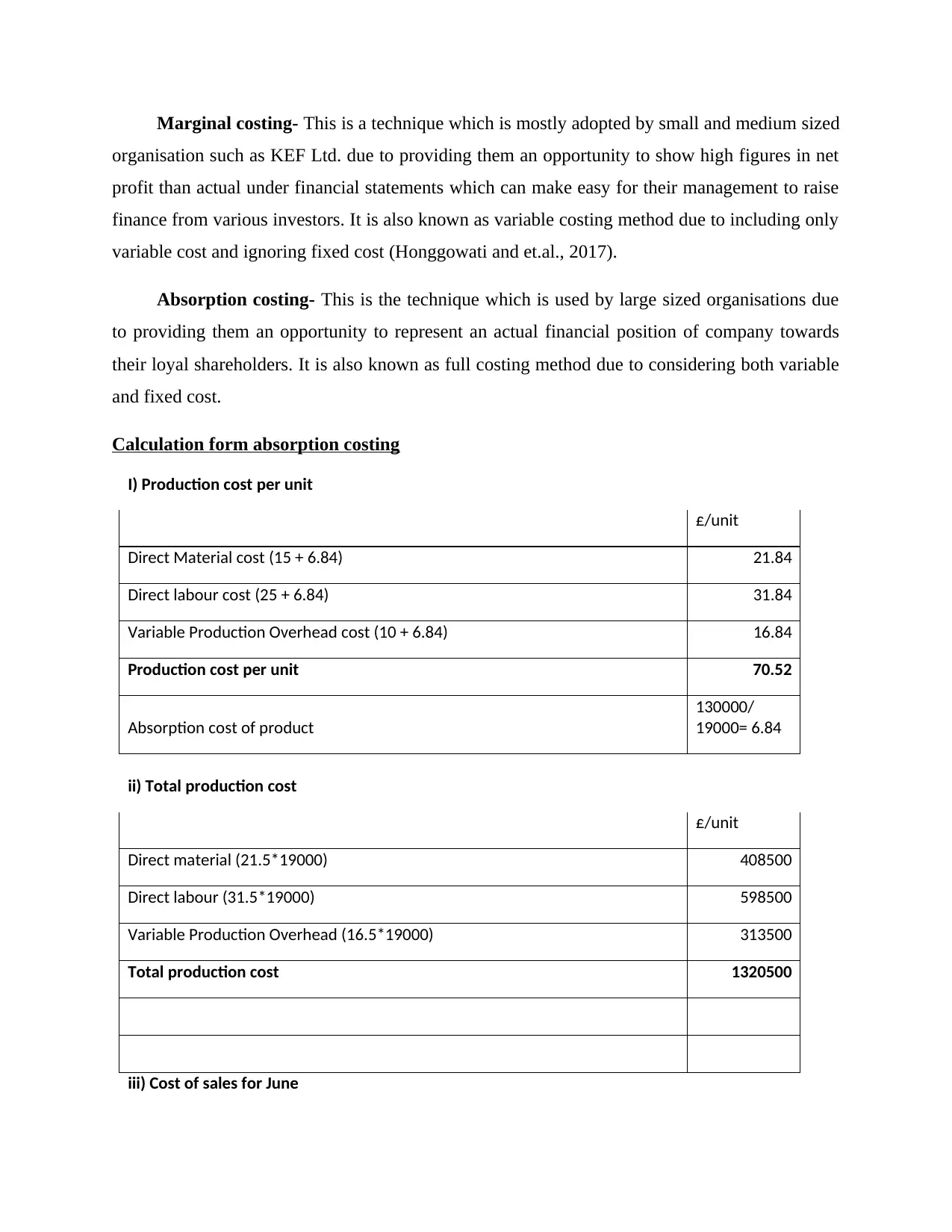
Marginal costing- This is a technique which is mostly adopted by small and medium sized
organisation such as KEF Ltd. due to providing them an opportunity to show high figures in net
profit than actual under financial statements which can make easy for their management to raise
finance from various investors. It is also known as variable costing method due to including only
variable cost and ignoring fixed cost (Honggowati and et.al., 2017).
Absorption costing- This is the technique which is used by large sized organisations due
to providing them an opportunity to represent an actual financial position of company towards
their loyal shareholders. It is also known as full costing method due to considering both variable
and fixed cost.
Calculation form absorption costing
I) Production cost per unit
£/unit
Direct Material cost (15 + 6.84) 21.84
Direct labour cost (25 + 6.84) 31.84
Variable Production Overhead cost (10 + 6.84) 16.84
Production cost per unit 70.52
Absorption cost of product
130000/
19000= 6.84
ii) Total production cost
£/unit
Direct material (21.5*19000) 408500
Direct labour (31.5*19000) 598500
Variable Production Overhead (16.5*19000) 313500
Total production cost 1320500
iii) Cost of sales for June
organisation such as KEF Ltd. due to providing them an opportunity to show high figures in net
profit than actual under financial statements which can make easy for their management to raise
finance from various investors. It is also known as variable costing method due to including only
variable cost and ignoring fixed cost (Honggowati and et.al., 2017).
Absorption costing- This is the technique which is used by large sized organisations due
to providing them an opportunity to represent an actual financial position of company towards
their loyal shareholders. It is also known as full costing method due to considering both variable
and fixed cost.
Calculation form absorption costing
I) Production cost per unit
£/unit
Direct Material cost (15 + 6.84) 21.84
Direct labour cost (25 + 6.84) 31.84
Variable Production Overhead cost (10 + 6.84) 16.84
Production cost per unit 70.52
Absorption cost of product
130000/
19000= 6.84
ii) Total production cost
£/unit
Direct material (21.5*19000) 408500
Direct labour (31.5*19000) 598500
Variable Production Overhead (16.5*19000) 313500
Total production cost 1320500
iii) Cost of sales for June
Paraphrase This Document
Need a fresh take? Get an instant paraphrase of this document with our AI Paraphraser
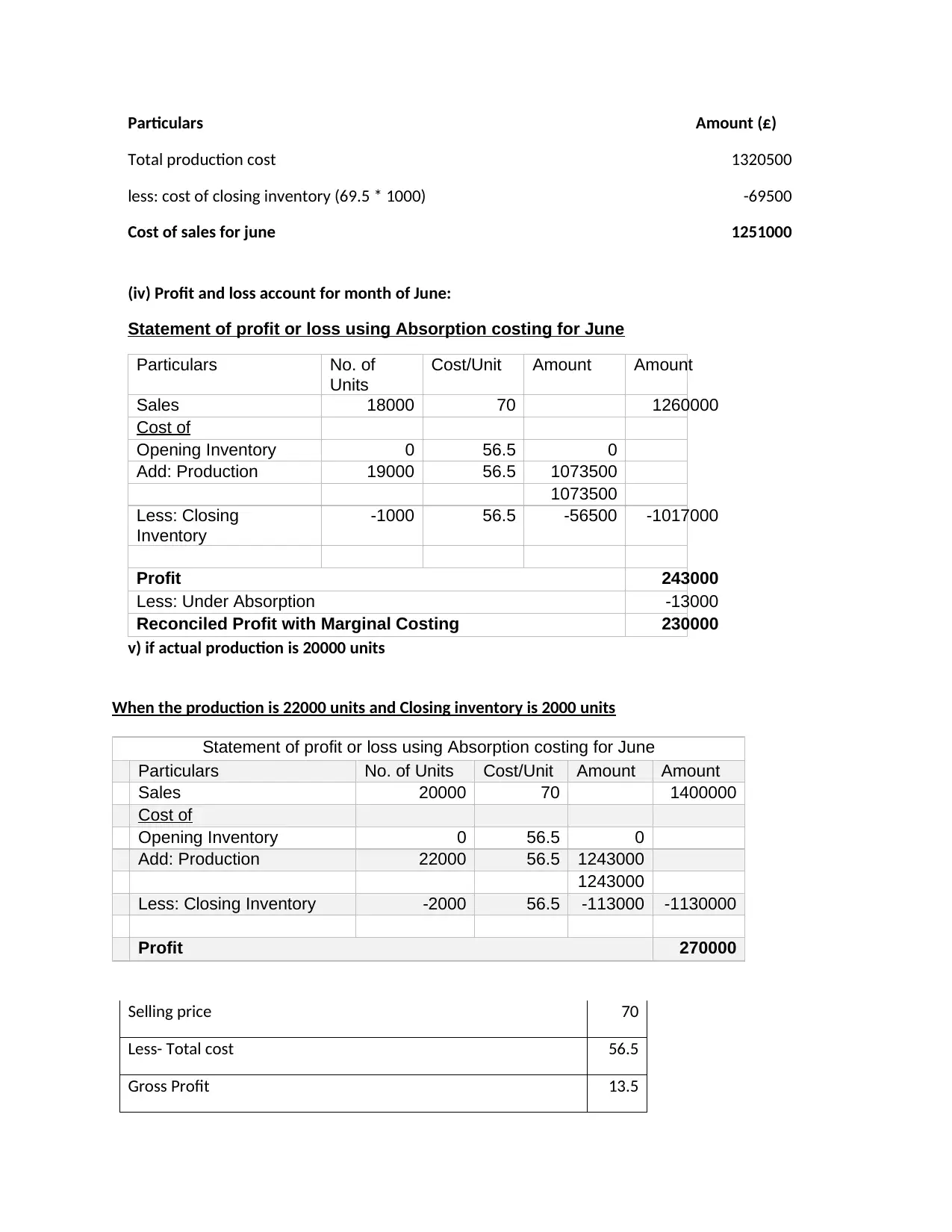
Particulars Amount (£)
Total production cost 1320500
less: cost of closing inventory (69.5 * 1000) -69500
Cost of sales for june 1251000
(iv) Profit and loss account for month of June:
Statement of profit or loss using Absorption costing for June
Particulars No. of
Units
Cost/Unit Amount Amount
Sales 18000 70 1260000
Cost of
Opening Inventory 0 56.5 0
Add: Production 19000 56.5 1073500
1073500
Less: Closing
Inventory
-1000 56.5 -56500 -1017000
Profit 243000
Less: Under Absorption -13000
Reconciled Profit with Marginal Costing 230000
v) if actual production is 20000 units
When the production is 22000 units and Closing inventory is 2000 units
Statement of profit or loss using Absorption costing for June
Particulars No. of Units Cost/Unit Amount Amount
Sales 20000 70 1400000
Cost of
Opening Inventory 0 56.5 0
Add: Production 22000 56.5 1243000
1243000
Less: Closing Inventory -2000 56.5 -113000 -1130000
Profit 270000
Selling price 70
Less- Total cost 56.5
Gross Profit 13.5
Total production cost 1320500
less: cost of closing inventory (69.5 * 1000) -69500
Cost of sales for june 1251000
(iv) Profit and loss account for month of June:
Statement of profit or loss using Absorption costing for June
Particulars No. of
Units
Cost/Unit Amount Amount
Sales 18000 70 1260000
Cost of
Opening Inventory 0 56.5 0
Add: Production 19000 56.5 1073500
1073500
Less: Closing
Inventory
-1000 56.5 -56500 -1017000
Profit 243000
Less: Under Absorption -13000
Reconciled Profit with Marginal Costing 230000
v) if actual production is 20000 units
When the production is 22000 units and Closing inventory is 2000 units
Statement of profit or loss using Absorption costing for June
Particulars No. of Units Cost/Unit Amount Amount
Sales 20000 70 1400000
Cost of
Opening Inventory 0 56.5 0
Add: Production 22000 56.5 1243000
1243000
Less: Closing Inventory -2000 56.5 -113000 -1130000
Profit 270000
Selling price 70
Less- Total cost 56.5
Gross Profit 13.5
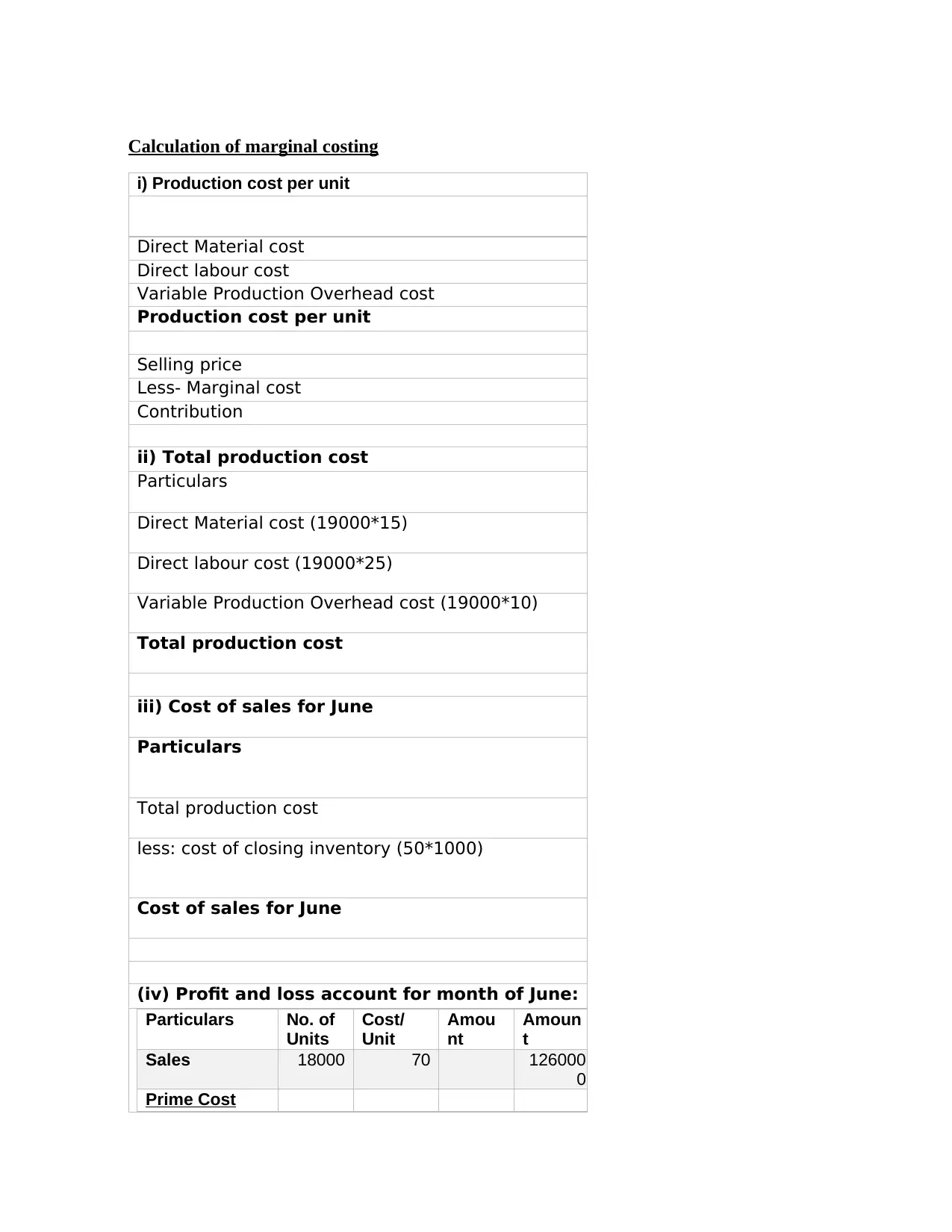
Calculation of marginal costing
i) Production cost per unit
Direct Material cost
Direct labour cost
Variable Production Overhead cost
Production cost per unit
Selling price
Less- Marginal cost
Contribution
ii) Total production cost
Particulars
Direct Material cost (19000*15)
Direct labour cost (19000*25)
Variable Production Overhead cost (19000*10)
Total production cost
iii) Cost of sales for June
Particulars
Total production cost
less: cost of closing inventory (50*1000)
Cost of sales for June
(iv) Profit and loss account for month of June:
Particulars No. of
Units
Cost/
Unit
Amou
nt
Amoun
t
Sales 18000 70 126000
0
Prime Cost
i) Production cost per unit
Direct Material cost
Direct labour cost
Variable Production Overhead cost
Production cost per unit
Selling price
Less- Marginal cost
Contribution
ii) Total production cost
Particulars
Direct Material cost (19000*15)
Direct labour cost (19000*25)
Variable Production Overhead cost (19000*10)
Total production cost
iii) Cost of sales for June
Particulars
Total production cost
less: cost of closing inventory (50*1000)
Cost of sales for June
(iv) Profit and loss account for month of June:
Particulars No. of
Units
Cost/
Unit
Amou
nt
Amoun
t
Sales 18000 70 126000
0
Prime Cost
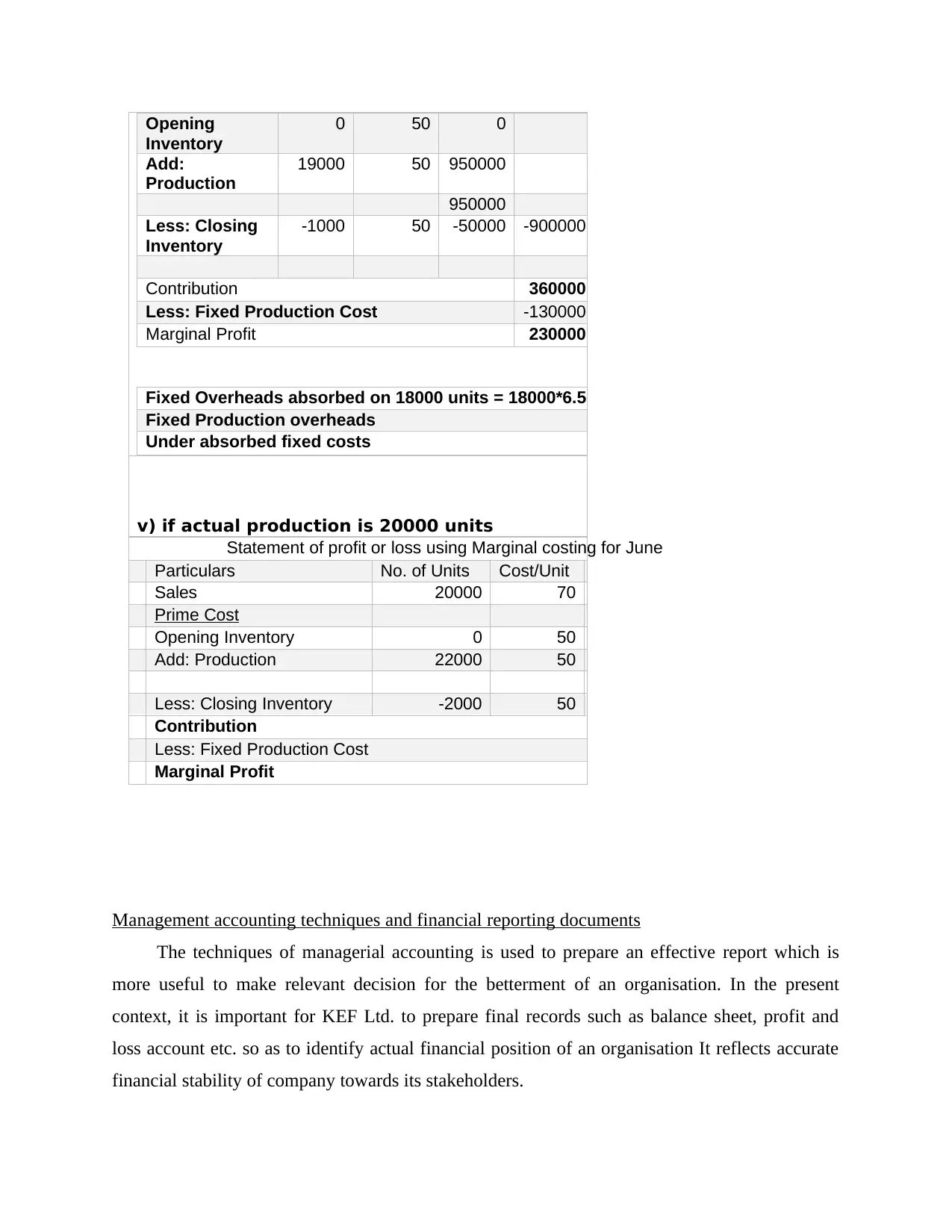
Opening
Inventory
0 50 0
Add:
Production
19000 50 950000
950000
Less: Closing
Inventory
-1000 50 -50000 -900000
Contribution 360000
Less: Fixed Production Cost -130000
Marginal Profit 230000
Fixed Overheads absorbed on 18000 units = 18000*6.5
Fixed Production overheads
Under absorbed fixed costs
v) if actual production is 20000 units
Statement of profit or loss using Marginal costing for June
Particulars No. of Units Cost/Unit
Sales 20000 70
Prime Cost
Opening Inventory 0 50
Add: Production 22000 50
Less: Closing Inventory -2000 50
Contribution
Less: Fixed Production Cost
Marginal Profit
Management accounting techniques and financial reporting documents
The techniques of managerial accounting is used to prepare an effective report which is
more useful to make relevant decision for the betterment of an organisation. In the present
context, it is important for KEF Ltd. to prepare final records such as balance sheet, profit and
loss account etc. so as to identify actual financial position of an organisation It reflects accurate
financial stability of company towards its stakeholders.
Inventory
0 50 0
Add:
Production
19000 50 950000
950000
Less: Closing
Inventory
-1000 50 -50000 -900000
Contribution 360000
Less: Fixed Production Cost -130000
Marginal Profit 230000
Fixed Overheads absorbed on 18000 units = 18000*6.5
Fixed Production overheads
Under absorbed fixed costs
v) if actual production is 20000 units
Statement of profit or loss using Marginal costing for June
Particulars No. of Units Cost/Unit
Sales 20000 70
Prime Cost
Opening Inventory 0 50
Add: Production 22000 50
Less: Closing Inventory -2000 50
Contribution
Less: Fixed Production Cost
Marginal Profit
Management accounting techniques and financial reporting documents
The techniques of managerial accounting is used to prepare an effective report which is
more useful to make relevant decision for the betterment of an organisation. In the present
context, it is important for KEF Ltd. to prepare final records such as balance sheet, profit and
loss account etc. so as to identify actual financial position of an organisation It reflects accurate
financial stability of company towards its stakeholders.
Secure Best Marks with AI Grader
Need help grading? Try our AI Grader for instant feedback on your assignments.
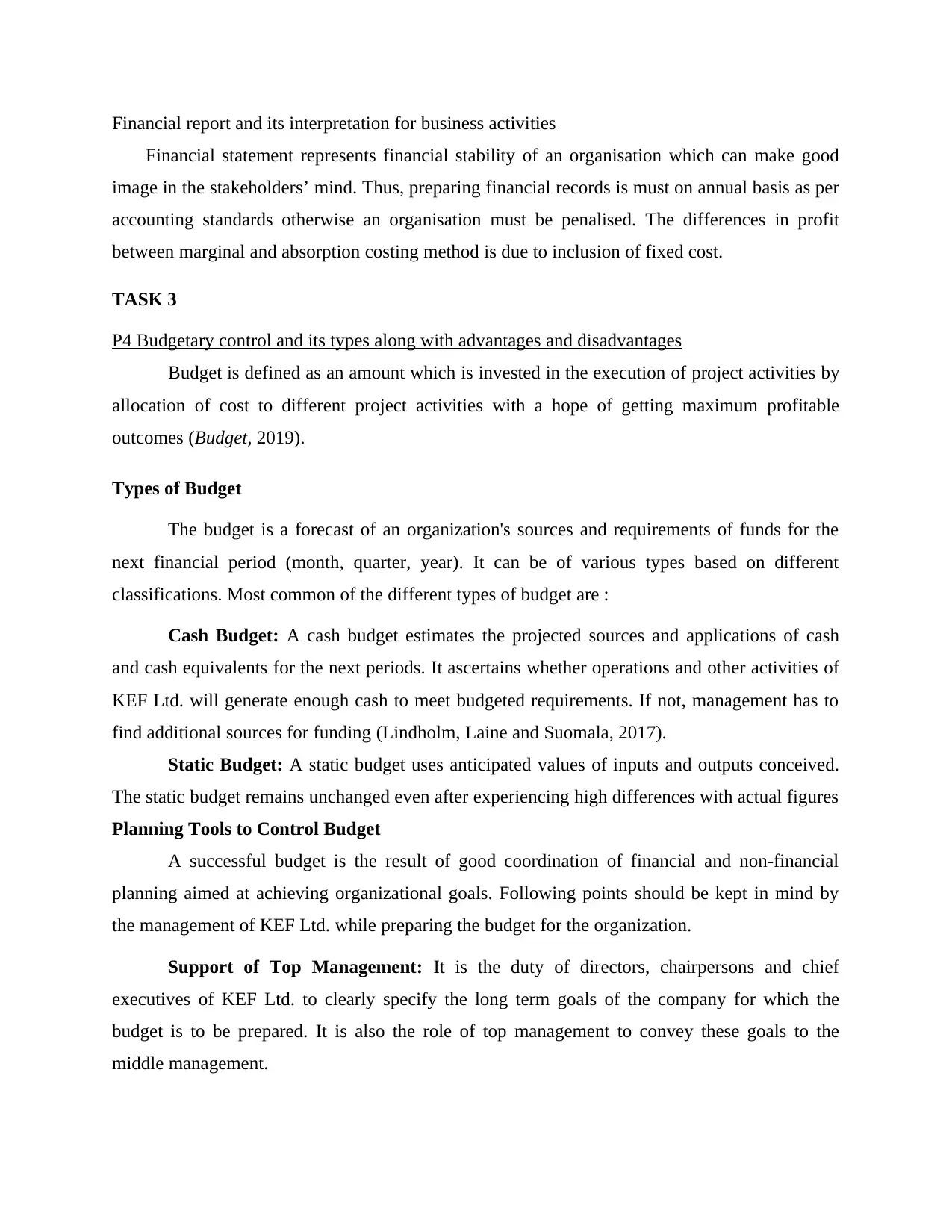
Financial report and its interpretation for business activities
Financial statement represents financial stability of an organisation which can make good
image in the stakeholders’ mind. Thus, preparing financial records is must on annual basis as per
accounting standards otherwise an organisation must be penalised. The differences in profit
between marginal and absorption costing method is due to inclusion of fixed cost.
TASK 3
P4 Budgetary control and its types along with advantages and disadvantages
Budget is defined as an amount which is invested in the execution of project activities by
allocation of cost to different project activities with a hope of getting maximum profitable
outcomes (Budget, 2019).
Types of Budget
The budget is a forecast of an organization's sources and requirements of funds for the
next financial period (month, quarter, year). It can be of various types based on different
classifications. Most common of the different types of budget are :
Cash Budget: A cash budget estimates the projected sources and applications of cash
and cash equivalents for the next periods. It ascertains whether operations and other activities of
KEF Ltd. will generate enough cash to meet budgeted requirements. If not, management has to
find additional sources for funding (Lindholm, Laine and Suomala, 2017).
Static Budget: A static budget uses anticipated values of inputs and outputs conceived.
The static budget remains unchanged even after experiencing high differences with actual figures
Planning Tools to Control Budget
A successful budget is the result of good coordination of financial and non-financial
planning aimed at achieving organizational goals. Following points should be kept in mind by
the management of KEF Ltd. while preparing the budget for the organization.
Support of Top Management: It is the duty of directors, chairpersons and chief
executives of KEF Ltd. to clearly specify the long term goals of the company for which the
budget is to be prepared. It is also the role of top management to convey these goals to the
middle management.
Financial statement represents financial stability of an organisation which can make good
image in the stakeholders’ mind. Thus, preparing financial records is must on annual basis as per
accounting standards otherwise an organisation must be penalised. The differences in profit
between marginal and absorption costing method is due to inclusion of fixed cost.
TASK 3
P4 Budgetary control and its types along with advantages and disadvantages
Budget is defined as an amount which is invested in the execution of project activities by
allocation of cost to different project activities with a hope of getting maximum profitable
outcomes (Budget, 2019).
Types of Budget
The budget is a forecast of an organization's sources and requirements of funds for the
next financial period (month, quarter, year). It can be of various types based on different
classifications. Most common of the different types of budget are :
Cash Budget: A cash budget estimates the projected sources and applications of cash
and cash equivalents for the next periods. It ascertains whether operations and other activities of
KEF Ltd. will generate enough cash to meet budgeted requirements. If not, management has to
find additional sources for funding (Lindholm, Laine and Suomala, 2017).
Static Budget: A static budget uses anticipated values of inputs and outputs conceived.
The static budget remains unchanged even after experiencing high differences with actual figures
Planning Tools to Control Budget
A successful budget is the result of good coordination of financial and non-financial
planning aimed at achieving organizational goals. Following points should be kept in mind by
the management of KEF Ltd. while preparing the budget for the organization.
Support of Top Management: It is the duty of directors, chairpersons and chief
executives of KEF Ltd. to clearly specify the long term goals of the company for which the
budget is to be prepared. It is also the role of top management to convey these goals to the
middle management.
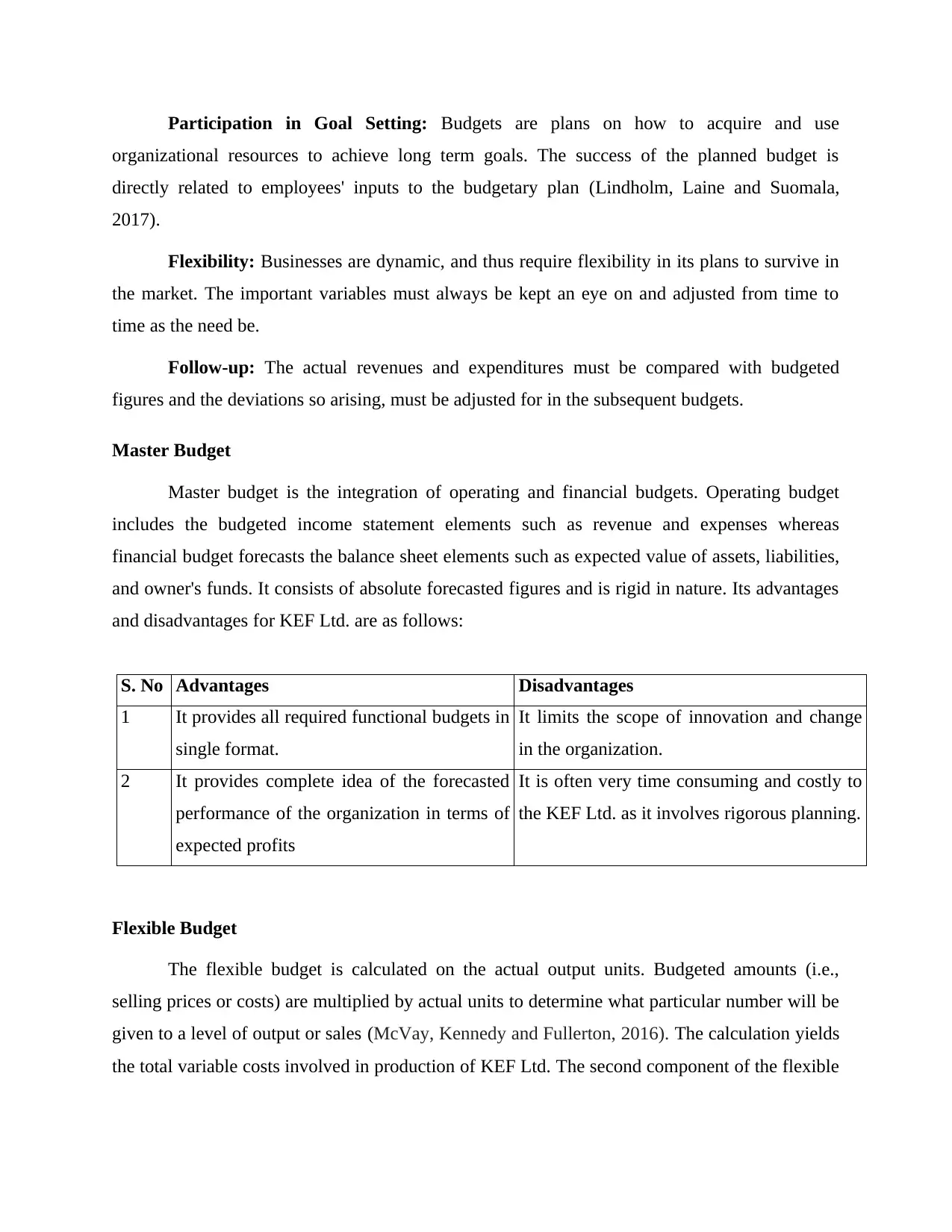
Participation in Goal Setting: Budgets are plans on how to acquire and use
organizational resources to achieve long term goals. The success of the planned budget is
directly related to employees' inputs to the budgetary plan (Lindholm, Laine and Suomala,
2017).
Flexibility: Businesses are dynamic, and thus require flexibility in its plans to survive in
the market. The important variables must always be kept an eye on and adjusted from time to
time as the need be.
Follow-up: The actual revenues and expenditures must be compared with budgeted
figures and the deviations so arising, must be adjusted for in the subsequent budgets.
Master Budget
Master budget is the integration of operating and financial budgets. Operating budget
includes the budgeted income statement elements such as revenue and expenses whereas
financial budget forecasts the balance sheet elements such as expected value of assets, liabilities,
and owner's funds. It consists of absolute forecasted figures and is rigid in nature. Its advantages
and disadvantages for KEF Ltd. are as follows:
S. No Advantages Disadvantages
1 It provides all required functional budgets in
single format.
It limits the scope of innovation and change
in the organization.
2 It provides complete idea of the forecasted
performance of the organization in terms of
expected profits
It is often very time consuming and costly to
the KEF Ltd. as it involves rigorous planning.
Flexible Budget
The flexible budget is calculated on the actual output units. Budgeted amounts (i.e.,
selling prices or costs) are multiplied by actual units to determine what particular number will be
given to a level of output or sales (McVay, Kennedy and Fullerton, 2016). The calculation yields
the total variable costs involved in production of KEF Ltd. The second component of the flexible
organizational resources to achieve long term goals. The success of the planned budget is
directly related to employees' inputs to the budgetary plan (Lindholm, Laine and Suomala,
2017).
Flexibility: Businesses are dynamic, and thus require flexibility in its plans to survive in
the market. The important variables must always be kept an eye on and adjusted from time to
time as the need be.
Follow-up: The actual revenues and expenditures must be compared with budgeted
figures and the deviations so arising, must be adjusted for in the subsequent budgets.
Master Budget
Master budget is the integration of operating and financial budgets. Operating budget
includes the budgeted income statement elements such as revenue and expenses whereas
financial budget forecasts the balance sheet elements such as expected value of assets, liabilities,
and owner's funds. It consists of absolute forecasted figures and is rigid in nature. Its advantages
and disadvantages for KEF Ltd. are as follows:
S. No Advantages Disadvantages
1 It provides all required functional budgets in
single format.
It limits the scope of innovation and change
in the organization.
2 It provides complete idea of the forecasted
performance of the organization in terms of
expected profits
It is often very time consuming and costly to
the KEF Ltd. as it involves rigorous planning.
Flexible Budget
The flexible budget is calculated on the actual output units. Budgeted amounts (i.e.,
selling prices or costs) are multiplied by actual units to determine what particular number will be
given to a level of output or sales (McVay, Kennedy and Fullerton, 2016). The calculation yields
the total variable costs involved in production of KEF Ltd. The second component of the flexible
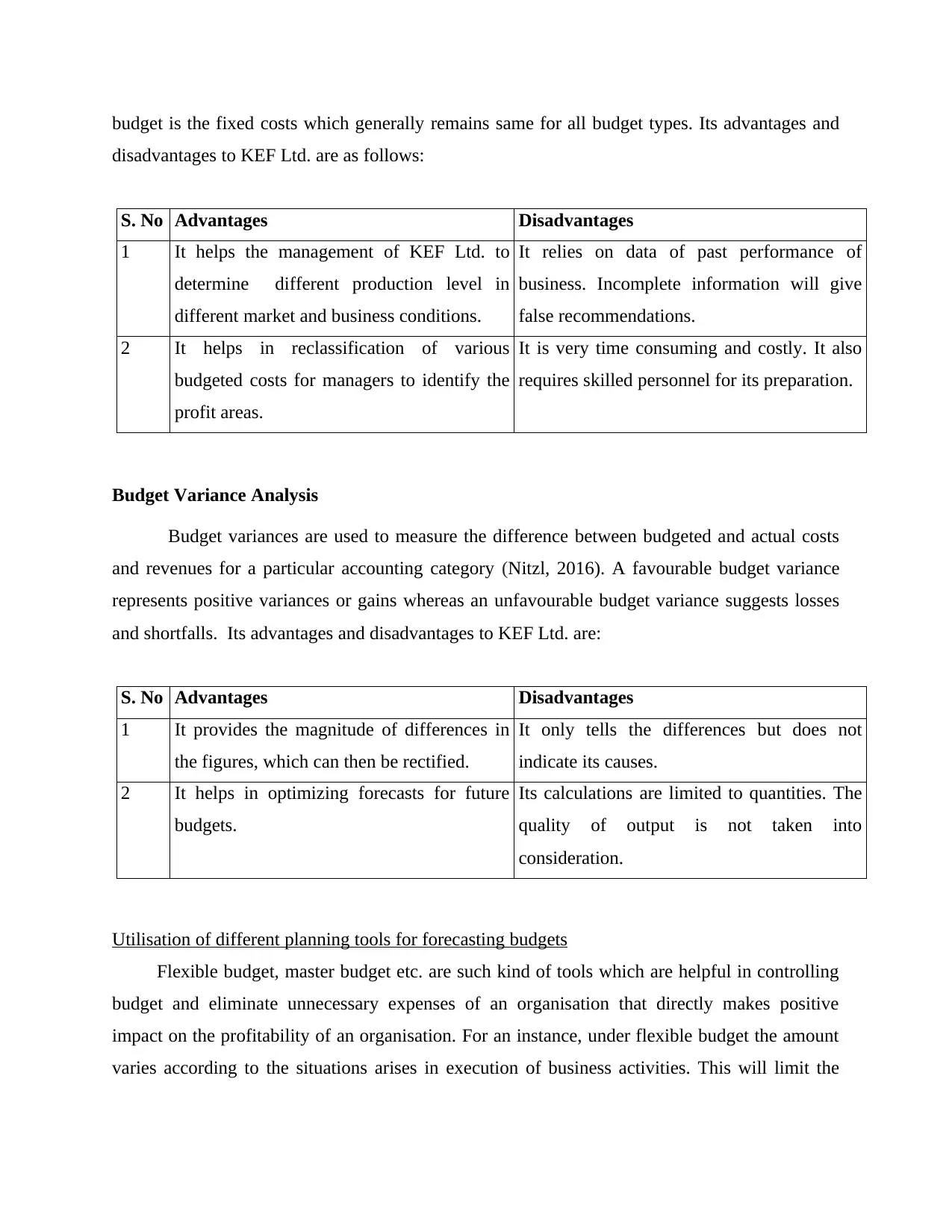
budget is the fixed costs which generally remains same for all budget types. Its advantages and
disadvantages to KEF Ltd. are as follows:
S. No Advantages Disadvantages
1 It helps the management of KEF Ltd. to
determine different production level in
different market and business conditions.
It relies on data of past performance of
business. Incomplete information will give
false recommendations.
2 It helps in reclassification of various
budgeted costs for managers to identify the
profit areas.
It is very time consuming and costly. It also
requires skilled personnel for its preparation.
Budget Variance Analysis
Budget variances are used to measure the difference between budgeted and actual costs
and revenues for a particular accounting category (Nitzl, 2016). A favourable budget variance
represents positive variances or gains whereas an unfavourable budget variance suggests losses
and shortfalls. Its advantages and disadvantages to KEF Ltd. are:
S. No Advantages Disadvantages
1 It provides the magnitude of differences in
the figures, which can then be rectified.
It only tells the differences but does not
indicate its causes.
2 It helps in optimizing forecasts for future
budgets.
Its calculations are limited to quantities. The
quality of output is not taken into
consideration.
Utilisation of different planning tools for forecasting budgets
Flexible budget, master budget etc. are such kind of tools which are helpful in controlling
budget and eliminate unnecessary expenses of an organisation that directly makes positive
impact on the profitability of an organisation. For an instance, under flexible budget the amount
varies according to the situations arises in execution of business activities. This will limit the
disadvantages to KEF Ltd. are as follows:
S. No Advantages Disadvantages
1 It helps the management of KEF Ltd. to
determine different production level in
different market and business conditions.
It relies on data of past performance of
business. Incomplete information will give
false recommendations.
2 It helps in reclassification of various
budgeted costs for managers to identify the
profit areas.
It is very time consuming and costly. It also
requires skilled personnel for its preparation.
Budget Variance Analysis
Budget variances are used to measure the difference between budgeted and actual costs
and revenues for a particular accounting category (Nitzl, 2016). A favourable budget variance
represents positive variances or gains whereas an unfavourable budget variance suggests losses
and shortfalls. Its advantages and disadvantages to KEF Ltd. are:
S. No Advantages Disadvantages
1 It provides the magnitude of differences in
the figures, which can then be rectified.
It only tells the differences but does not
indicate its causes.
2 It helps in optimizing forecasts for future
budgets.
Its calculations are limited to quantities. The
quality of output is not taken into
consideration.
Utilisation of different planning tools for forecasting budgets
Flexible budget, master budget etc. are such kind of tools which are helpful in controlling
budget and eliminate unnecessary expenses of an organisation that directly makes positive
impact on the profitability of an organisation. For an instance, under flexible budget the amount
varies according to the situations arises in execution of business activities. This will limit the
Paraphrase This Document
Need a fresh take? Get an instant paraphrase of this document with our AI Paraphraser
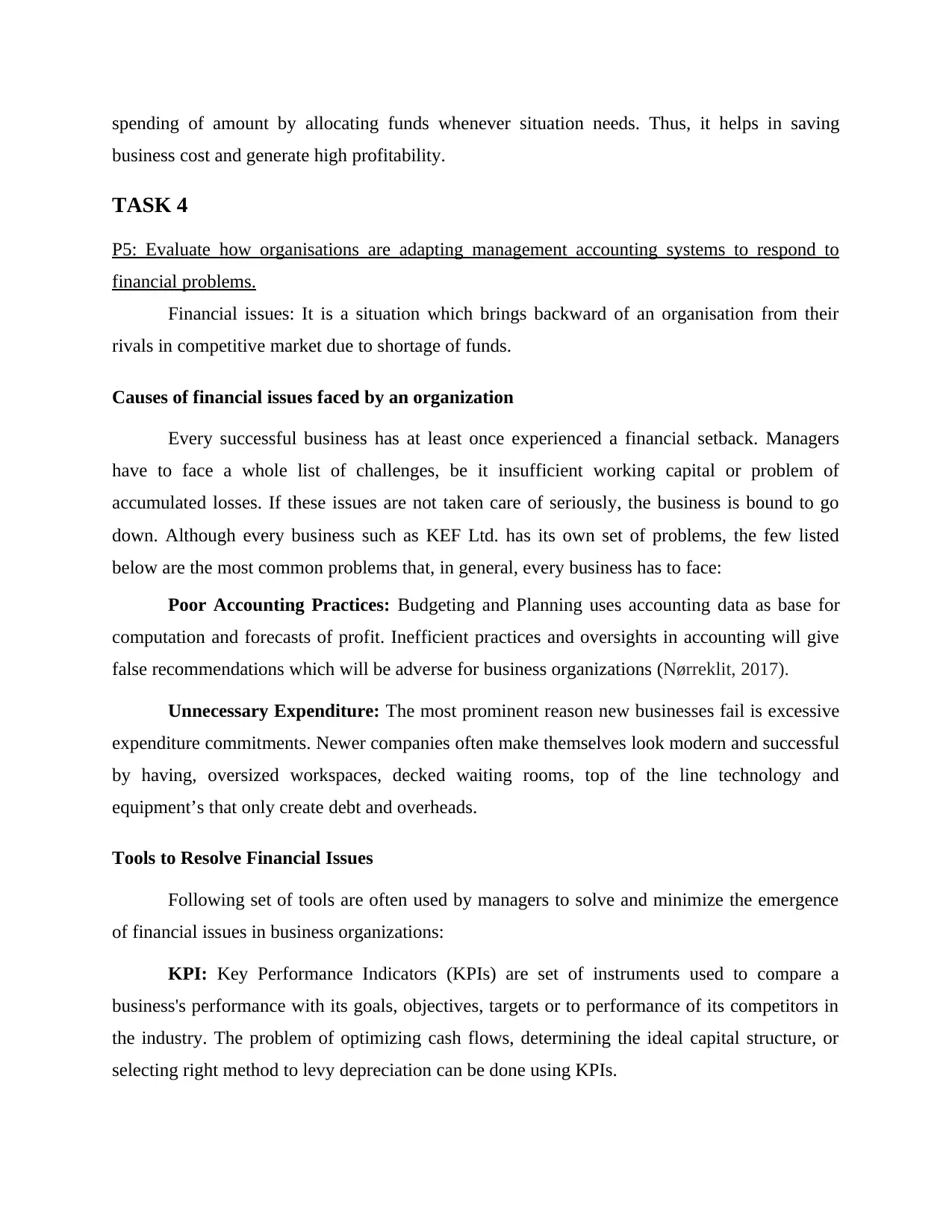
spending of amount by allocating funds whenever situation needs. Thus, it helps in saving
business cost and generate high profitability.
TASK 4
P5: Evaluate how organisations are adapting management accounting systems to respond to
financial problems.
Financial issues: It is a situation which brings backward of an organisation from their
rivals in competitive market due to shortage of funds.
Causes of financial issues faced by an organization
Every successful business has at least once experienced a financial setback. Managers
have to face a whole list of challenges, be it insufficient working capital or problem of
accumulated losses. If these issues are not taken care of seriously, the business is bound to go
down. Although every business such as KEF Ltd. has its own set of problems, the few listed
below are the most common problems that, in general, every business has to face:
Poor Accounting Practices: Budgeting and Planning uses accounting data as base for
computation and forecasts of profit. Inefficient practices and oversights in accounting will give
false recommendations which will be adverse for business organizations (Nørreklit, 2017).
Unnecessary Expenditure: The most prominent reason new businesses fail is excessive
expenditure commitments. Newer companies often make themselves look modern and successful
by having, oversized workspaces, decked waiting rooms, top of the line technology and
equipment’s that only create debt and overheads.
Tools to Resolve Financial Issues
Following set of tools are often used by managers to solve and minimize the emergence
of financial issues in business organizations:
KPI: Key Performance Indicators (KPIs) are set of instruments used to compare a
business's performance with its goals, objectives, targets or to performance of its competitors in
the industry. The problem of optimizing cash flows, determining the ideal capital structure, or
selecting right method to levy depreciation can be done using KPIs.
business cost and generate high profitability.
TASK 4
P5: Evaluate how organisations are adapting management accounting systems to respond to
financial problems.
Financial issues: It is a situation which brings backward of an organisation from their
rivals in competitive market due to shortage of funds.
Causes of financial issues faced by an organization
Every successful business has at least once experienced a financial setback. Managers
have to face a whole list of challenges, be it insufficient working capital or problem of
accumulated losses. If these issues are not taken care of seriously, the business is bound to go
down. Although every business such as KEF Ltd. has its own set of problems, the few listed
below are the most common problems that, in general, every business has to face:
Poor Accounting Practices: Budgeting and Planning uses accounting data as base for
computation and forecasts of profit. Inefficient practices and oversights in accounting will give
false recommendations which will be adverse for business organizations (Nørreklit, 2017).
Unnecessary Expenditure: The most prominent reason new businesses fail is excessive
expenditure commitments. Newer companies often make themselves look modern and successful
by having, oversized workspaces, decked waiting rooms, top of the line technology and
equipment’s that only create debt and overheads.
Tools to Resolve Financial Issues
Following set of tools are often used by managers to solve and minimize the emergence
of financial issues in business organizations:
KPI: Key Performance Indicators (KPIs) are set of instruments used to compare a
business's performance with its goals, objectives, targets or to performance of its competitors in
the industry. The problem of optimizing cash flows, determining the ideal capital structure, or
selecting right method to levy depreciation can be done using KPIs.
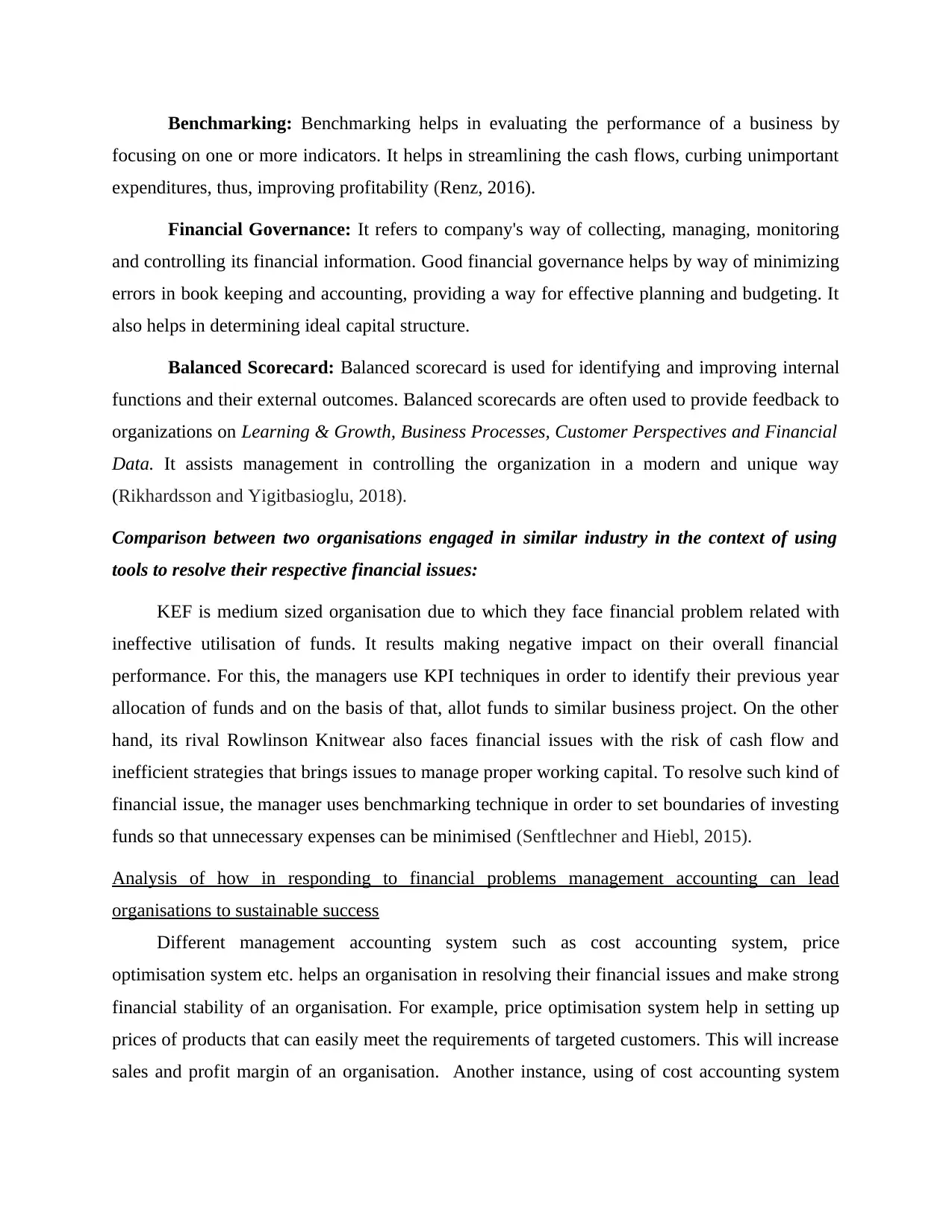
Benchmarking: Benchmarking helps in evaluating the performance of a business by
focusing on one or more indicators. It helps in streamlining the cash flows, curbing unimportant
expenditures, thus, improving profitability (Renz, 2016).
Financial Governance: It refers to company's way of collecting, managing, monitoring
and controlling its financial information. Good financial governance helps by way of minimizing
errors in book keeping and accounting, providing a way for effective planning and budgeting. It
also helps in determining ideal capital structure.
Balanced Scorecard: Balanced scorecard is used for identifying and improving internal
functions and their external outcomes. Balanced scorecards are often used to provide feedback to
organizations on Learning & Growth, Business Processes, Customer Perspectives and Financial
Data. It assists management in controlling the organization in a modern and unique way
(Rikhardsson and Yigitbasioglu, 2018).
Comparison between two organisations engaged in similar industry in the context of using
tools to resolve their respective financial issues:
KEF is medium sized organisation due to which they face financial problem related with
ineffective utilisation of funds. It results making negative impact on their overall financial
performance. For this, the managers use KPI techniques in order to identify their previous year
allocation of funds and on the basis of that, allot funds to similar business project. On the other
hand, its rival Rowlinson Knitwear also faces financial issues with the risk of cash flow and
inefficient strategies that brings issues to manage proper working capital. To resolve such kind of
financial issue, the manager uses benchmarking technique in order to set boundaries of investing
funds so that unnecessary expenses can be minimised (Senftlechner and Hiebl, 2015).
Analysis of how in responding to financial problems management accounting can lead
organisations to sustainable success
Different management accounting system such as cost accounting system, price
optimisation system etc. helps an organisation in resolving their financial issues and make strong
financial stability of an organisation. For example, price optimisation system help in setting up
prices of products that can easily meet the requirements of targeted customers. This will increase
sales and profit margin of an organisation. Another instance, using of cost accounting system
focusing on one or more indicators. It helps in streamlining the cash flows, curbing unimportant
expenditures, thus, improving profitability (Renz, 2016).
Financial Governance: It refers to company's way of collecting, managing, monitoring
and controlling its financial information. Good financial governance helps by way of minimizing
errors in book keeping and accounting, providing a way for effective planning and budgeting. It
also helps in determining ideal capital structure.
Balanced Scorecard: Balanced scorecard is used for identifying and improving internal
functions and their external outcomes. Balanced scorecards are often used to provide feedback to
organizations on Learning & Growth, Business Processes, Customer Perspectives and Financial
Data. It assists management in controlling the organization in a modern and unique way
(Rikhardsson and Yigitbasioglu, 2018).
Comparison between two organisations engaged in similar industry in the context of using
tools to resolve their respective financial issues:
KEF is medium sized organisation due to which they face financial problem related with
ineffective utilisation of funds. It results making negative impact on their overall financial
performance. For this, the managers use KPI techniques in order to identify their previous year
allocation of funds and on the basis of that, allot funds to similar business project. On the other
hand, its rival Rowlinson Knitwear also faces financial issues with the risk of cash flow and
inefficient strategies that brings issues to manage proper working capital. To resolve such kind of
financial issue, the manager uses benchmarking technique in order to set boundaries of investing
funds so that unnecessary expenses can be minimised (Senftlechner and Hiebl, 2015).
Analysis of how in responding to financial problems management accounting can lead
organisations to sustainable success
Different management accounting system such as cost accounting system, price
optimisation system etc. helps an organisation in resolving their financial issues and make strong
financial stability of an organisation. For example, price optimisation system help in setting up
prices of products that can easily meet the requirements of targeted customers. This will increase
sales and profit margin of an organisation. Another instance, using of cost accounting system
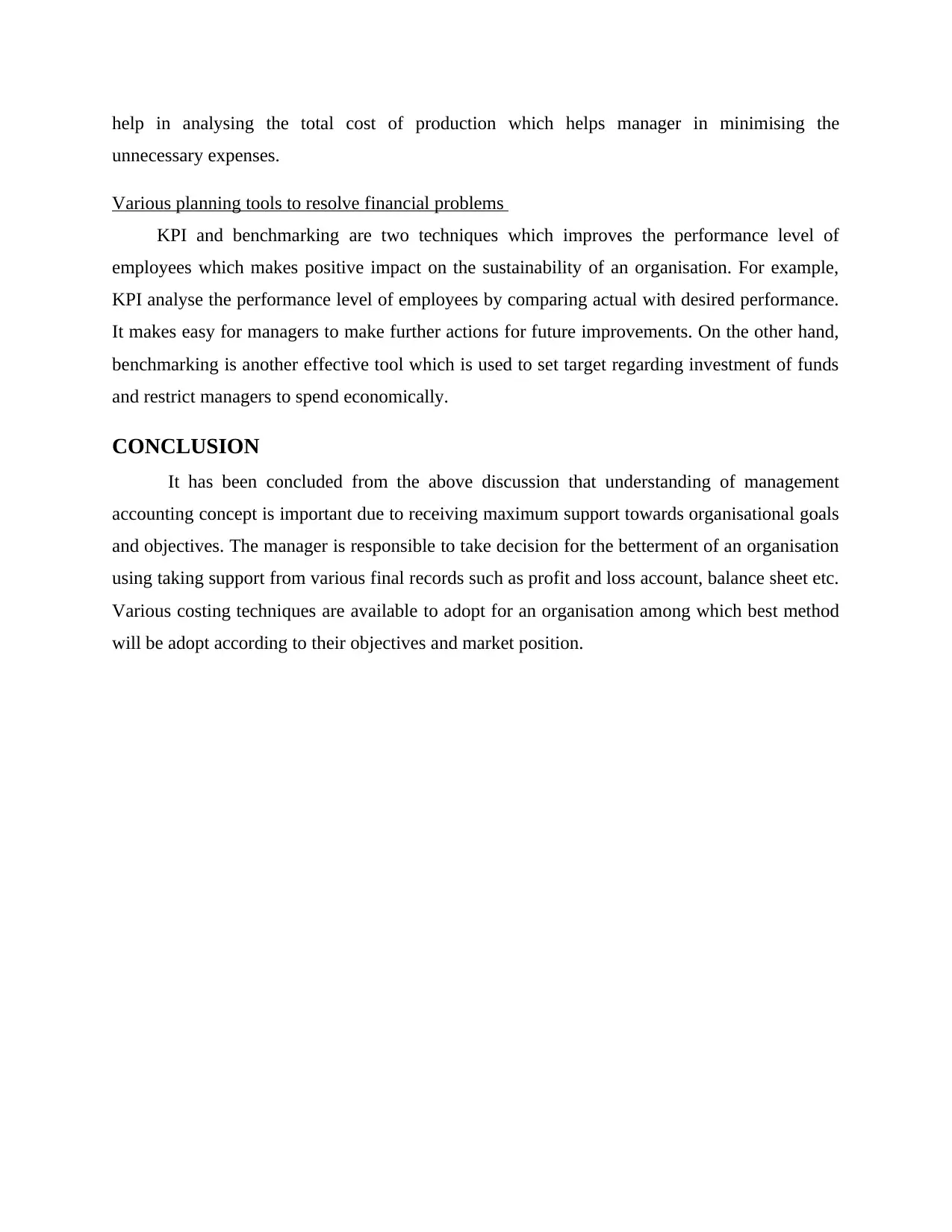
help in analysing the total cost of production which helps manager in minimising the
unnecessary expenses.
Various planning tools to resolve financial problems
KPI and benchmarking are two techniques which improves the performance level of
employees which makes positive impact on the sustainability of an organisation. For example,
KPI analyse the performance level of employees by comparing actual with desired performance.
It makes easy for managers to make further actions for future improvements. On the other hand,
benchmarking is another effective tool which is used to set target regarding investment of funds
and restrict managers to spend economically.
CONCLUSION
It has been concluded from the above discussion that understanding of management
accounting concept is important due to receiving maximum support towards organisational goals
and objectives. The manager is responsible to take decision for the betterment of an organisation
using taking support from various final records such as profit and loss account, balance sheet etc.
Various costing techniques are available to adopt for an organisation among which best method
will be adopt according to their objectives and market position.
unnecessary expenses.
Various planning tools to resolve financial problems
KPI and benchmarking are two techniques which improves the performance level of
employees which makes positive impact on the sustainability of an organisation. For example,
KPI analyse the performance level of employees by comparing actual with desired performance.
It makes easy for managers to make further actions for future improvements. On the other hand,
benchmarking is another effective tool which is used to set target regarding investment of funds
and restrict managers to spend economically.
CONCLUSION
It has been concluded from the above discussion that understanding of management
accounting concept is important due to receiving maximum support towards organisational goals
and objectives. The manager is responsible to take decision for the betterment of an organisation
using taking support from various final records such as profit and loss account, balance sheet etc.
Various costing techniques are available to adopt for an organisation among which best method
will be adopt according to their objectives and market position.
Secure Best Marks with AI Grader
Need help grading? Try our AI Grader for instant feedback on your assignments.
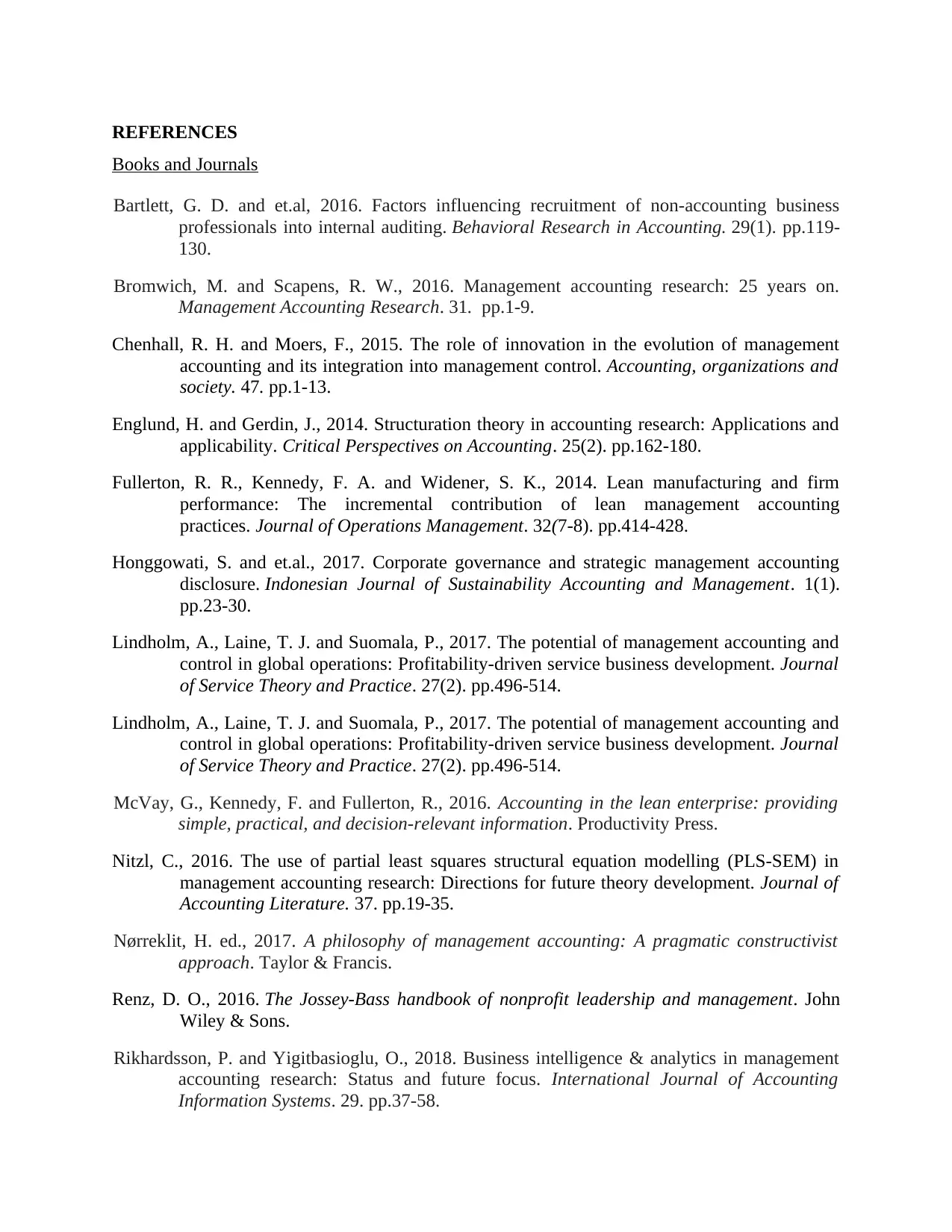
REFERENCES
Books and Journals
Bartlett, G. D. and et.al, 2016. Factors influencing recruitment of non-accounting business
professionals into internal auditing. Behavioral Research in Accounting. 29(1). pp.119-
130.
Bromwich, M. and Scapens, R. W., 2016. Management accounting research: 25 years on.
Management Accounting Research. 31. pp.1-9.
Chenhall, R. H. and Moers, F., 2015. The role of innovation in the evolution of management
accounting and its integration into management control. Accounting, organizations and
society. 47. pp.1-13.
Englund, H. and Gerdin, J., 2014. Structuration theory in accounting research: Applications and
applicability. Critical Perspectives on Accounting. 25(2). pp.162-180.
Fullerton, R. R., Kennedy, F. A. and Widener, S. K., 2014. Lean manufacturing and firm
performance: The incremental contribution of lean management accounting
practices. Journal of Operations Management. 32(7-8). pp.414-428.
Honggowati, S. and et.al., 2017. Corporate governance and strategic management accounting
disclosure. Indonesian Journal of Sustainability Accounting and Management. 1(1).
pp.23-30.
Lindholm, A., Laine, T. J. and Suomala, P., 2017. The potential of management accounting and
control in global operations: Profitability-driven service business development. Journal
of Service Theory and Practice. 27(2). pp.496-514.
Lindholm, A., Laine, T. J. and Suomala, P., 2017. The potential of management accounting and
control in global operations: Profitability-driven service business development. Journal
of Service Theory and Practice. 27(2). pp.496-514.
McVay, G., Kennedy, F. and Fullerton, R., 2016. Accounting in the lean enterprise: providing
simple, practical, and decision-relevant information. Productivity Press.
Nitzl, C., 2016. The use of partial least squares structural equation modelling (PLS-SEM) in
management accounting research: Directions for future theory development. Journal of
Accounting Literature. 37. pp.19-35.
Nørreklit, H. ed., 2017. A philosophy of management accounting: A pragmatic constructivist
approach. Taylor & Francis.
Renz, D. O., 2016. The Jossey-Bass handbook of nonprofit leadership and management. John
Wiley & Sons.
Rikhardsson, P. and Yigitbasioglu, O., 2018. Business intelligence & analytics in management
accounting research: Status and future focus. International Journal of Accounting
Information Systems. 29. pp.37-58.
Books and Journals
Bartlett, G. D. and et.al, 2016. Factors influencing recruitment of non-accounting business
professionals into internal auditing. Behavioral Research in Accounting. 29(1). pp.119-
130.
Bromwich, M. and Scapens, R. W., 2016. Management accounting research: 25 years on.
Management Accounting Research. 31. pp.1-9.
Chenhall, R. H. and Moers, F., 2015. The role of innovation in the evolution of management
accounting and its integration into management control. Accounting, organizations and
society. 47. pp.1-13.
Englund, H. and Gerdin, J., 2014. Structuration theory in accounting research: Applications and
applicability. Critical Perspectives on Accounting. 25(2). pp.162-180.
Fullerton, R. R., Kennedy, F. A. and Widener, S. K., 2014. Lean manufacturing and firm
performance: The incremental contribution of lean management accounting
practices. Journal of Operations Management. 32(7-8). pp.414-428.
Honggowati, S. and et.al., 2017. Corporate governance and strategic management accounting
disclosure. Indonesian Journal of Sustainability Accounting and Management. 1(1).
pp.23-30.
Lindholm, A., Laine, T. J. and Suomala, P., 2017. The potential of management accounting and
control in global operations: Profitability-driven service business development. Journal
of Service Theory and Practice. 27(2). pp.496-514.
Lindholm, A., Laine, T. J. and Suomala, P., 2017. The potential of management accounting and
control in global operations: Profitability-driven service business development. Journal
of Service Theory and Practice. 27(2). pp.496-514.
McVay, G., Kennedy, F. and Fullerton, R., 2016. Accounting in the lean enterprise: providing
simple, practical, and decision-relevant information. Productivity Press.
Nitzl, C., 2016. The use of partial least squares structural equation modelling (PLS-SEM) in
management accounting research: Directions for future theory development. Journal of
Accounting Literature. 37. pp.19-35.
Nørreklit, H. ed., 2017. A philosophy of management accounting: A pragmatic constructivist
approach. Taylor & Francis.
Renz, D. O., 2016. The Jossey-Bass handbook of nonprofit leadership and management. John
Wiley & Sons.
Rikhardsson, P. and Yigitbasioglu, O., 2018. Business intelligence & analytics in management
accounting research: Status and future focus. International Journal of Accounting
Information Systems. 29. pp.37-58.
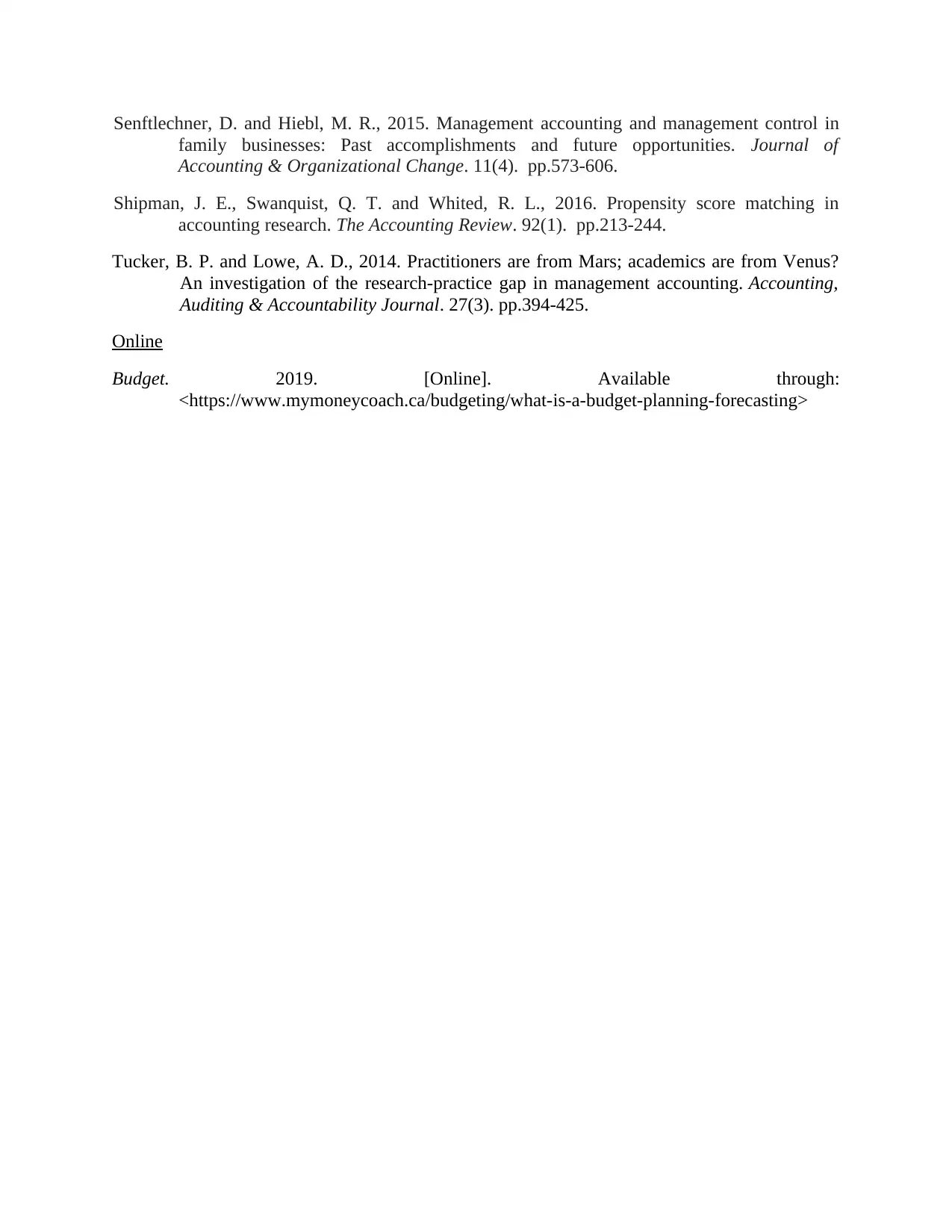
Senftlechner, D. and Hiebl, M. R., 2015. Management accounting and management control in
family businesses: Past accomplishments and future opportunities. Journal of
Accounting & Organizational Change. 11(4). pp.573-606.
Shipman, J. E., Swanquist, Q. T. and Whited, R. L., 2016. Propensity score matching in
accounting research. The Accounting Review. 92(1). pp.213-244.
Tucker, B. P. and Lowe, A. D., 2014. Practitioners are from Mars; academics are from Venus?
An investigation of the research-practice gap in management accounting. Accounting,
Auditing & Accountability Journal. 27(3). pp.394-425.
Online
Budget. 2019. [Online]. Available through:
<https://www.mymoneycoach.ca/budgeting/what-is-a-budget-planning-forecasting>
family businesses: Past accomplishments and future opportunities. Journal of
Accounting & Organizational Change. 11(4). pp.573-606.
Shipman, J. E., Swanquist, Q. T. and Whited, R. L., 2016. Propensity score matching in
accounting research. The Accounting Review. 92(1). pp.213-244.
Tucker, B. P. and Lowe, A. D., 2014. Practitioners are from Mars; academics are from Venus?
An investigation of the research-practice gap in management accounting. Accounting,
Auditing & Accountability Journal. 27(3). pp.394-425.
Online
Budget. 2019. [Online]. Available through:
<https://www.mymoneycoach.ca/budgeting/what-is-a-budget-planning-forecasting>
1 out of 18
Related Documents
Your All-in-One AI-Powered Toolkit for Academic Success.
+13062052269
info@desklib.com
Available 24*7 on WhatsApp / Email
![[object Object]](/_next/static/media/star-bottom.7253800d.svg)
Unlock your academic potential
© 2024 | Zucol Services PVT LTD | All rights reserved.





